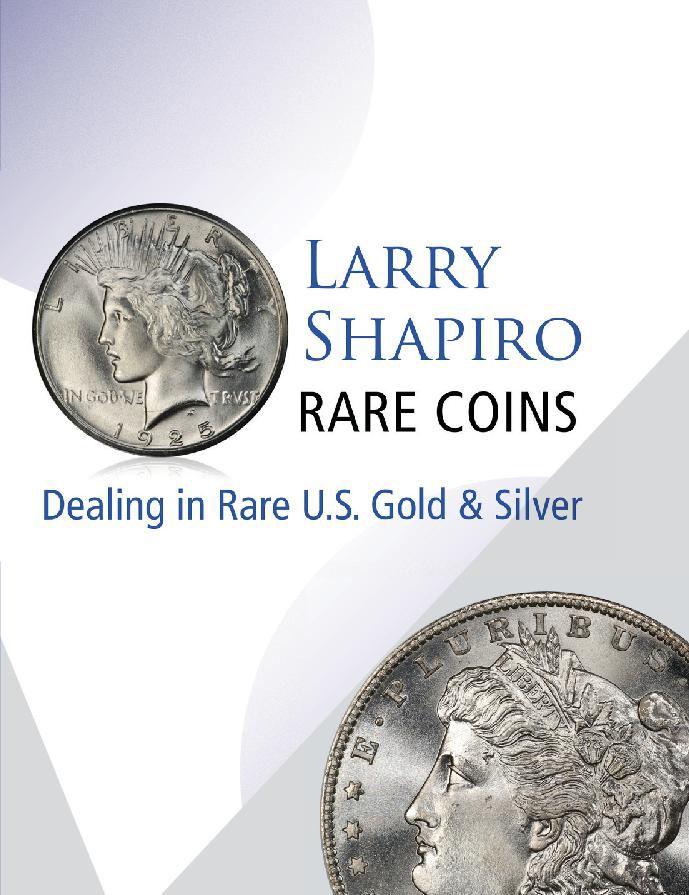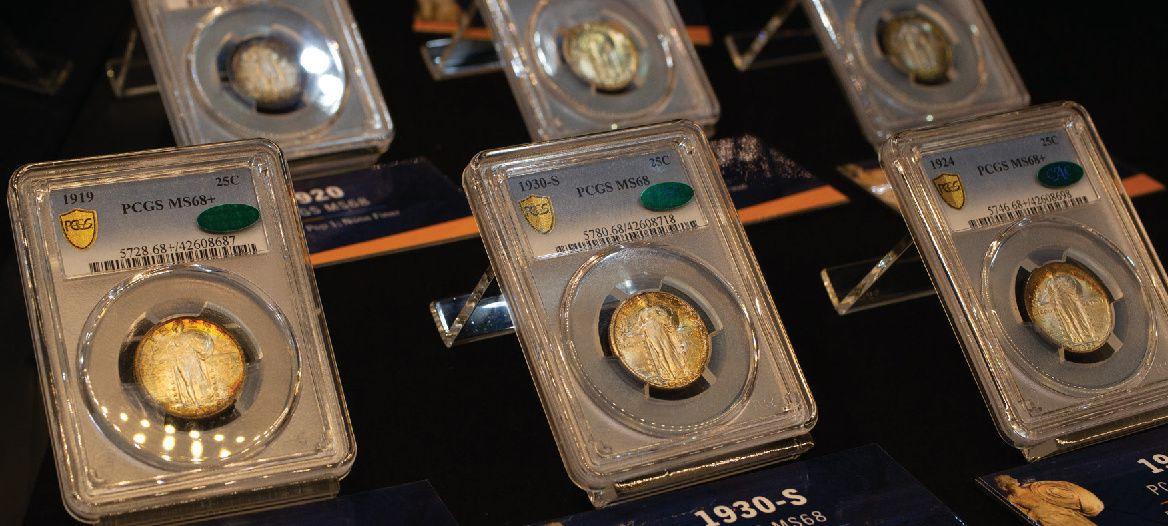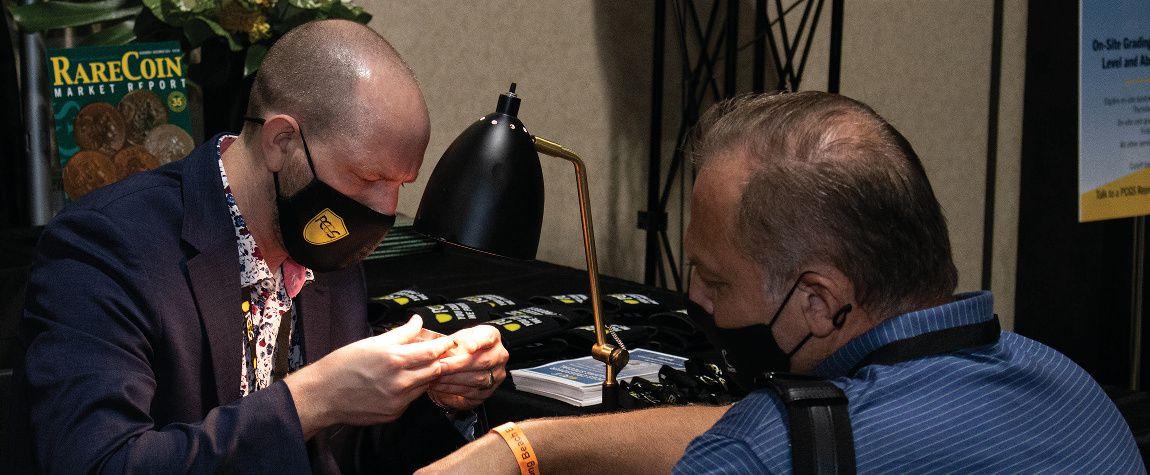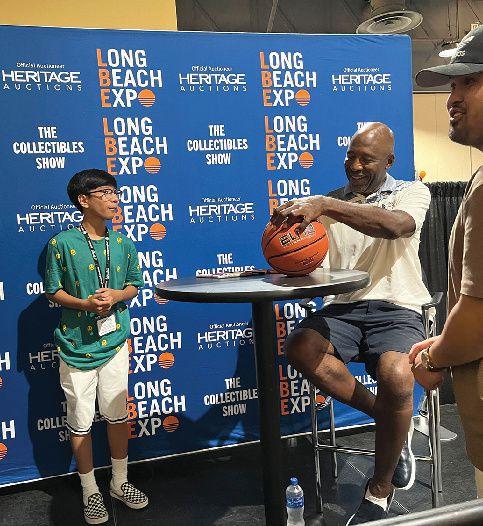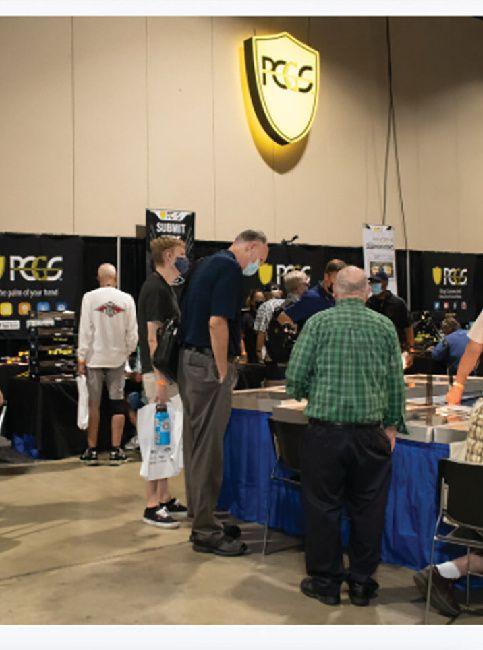













We have come to the end of 2022, and I’m thrilled to say we can look back on quite a colorful year. Over the past 12 months, we’ve expanded our informational and analytical content, dished the scoop on many exciting stories, and covered the gamut of our hobby, from coins and banknotes to tokens and medals – and much more. As the calendar thins to the last days of 2022, we also reflect on the tremendous growth we’ve seen at PCGS over the past year and look ahead to many new things that we will be unveiling here over the coming months.
To become a PCGS Authorized Dealer, contact: Dealer@PCGS.com
To become a PCGS Collectors Club member, go to www.PCGS.com/join
PrintedintheUnitedStates.Copyright2022Collectors Universe, Inc. All rights reserved. Reproduction of any kind without written permission of the publisher is prohibited by law. PCGS Rare Coin Market Report is published bi-monthly by Collectors Universe, Inc. at P.O. Box 9458, Newport Beach, CA 92658. Postmaster, send address change to Rare Coin Market Report c/o PCGS, Publication Department, P.O. Box 9458, Newport Beach, CA 92658.
Publication of this magazine is not a solicitation by the publisher, editor, or staff to buy or sell the coins listed herein.
Advertising,articlesandothercontentsofthismagazine sometimes contain inadvertent typographical errors, a fact readers should bear in mind when encountering pricing quoted at a fraction of prevailing market values. The publisher is not responsible for actions taken by any person because of such errors. Advertising prices are subject to change without notice.
Think our pricing is too low? Too high? Email us at CoinPrices@Collectors.com with the coin number, description, grade, published price, proposed price, reasoning and supportive evidence (like auction results). We'll be happy to review it! For advertising and content inquiries please email us at RCMR@PCGS.com
This issue offers a glimpse of the hobby’s most popular and active niches, among them low ball coins. What are they? You know how some collectors spend months, even years trying to achieve the highest-graded examples of a coin they can find? Well, low ball collectors have their sights set on acquiring the lowest-graded examples around, and you may be surprised just how challenging this can be. We speak with several collectors who have made low ball collecting their avocation. Wait ‘til you see just how low some of these coins go on the grading scale!
Another perennially hot area involves early branch-mint gold coinage, with specimens hailing from the Dahlonega Mint deep in the hills of northern Georgia both rare and extremely difficult to find with a decent strike. Doug Winter examines this matter in-depth, with a special look at the 1855-D Gold Dollar. World coins are always en vogue near and far, and Peter Anthony shares a story about a range of interesting Chinese coins profiling an important figure from Chinese folklore. Meanwhile, young numismatist Jacob Gonzalez shows us why Mexican coins are his favorite pursuit.
I guarantee some readers have already seen up-close and in-person at least some of the coins that are crossing the auction block as of late. Among them are rarities hailing from the legendary Harry W. Bass, Jr. Collection, which was on public display for two decades at the American Numismatic Association’s Money Museum in Colorado Springs, Colorado. Coins from this cabinet that have been entering the marketplace again include the unique 1870-S $3 Princess – one of the most sought-after coins of all time.
There are many other fantastic stories in this issue you’ll want to check out, including all the latest market buzz from your favorite columnists. It’s the kind of content that will help keep the atmosphere light and warm as those chestnuts roast over an open fire…
Exciting new changes are coming to the magazine beginning with the next issue, so please stay tuned. Until then, on behalf of everyone at the PCGS Rare Coin Market Report and myself, I would like to wish you and yours happy holidays and a prosperous 2023!
Sincerely, Joshua McMorrow-Hernandez Editor-in-Chief, PCGS Rare Coin Market Report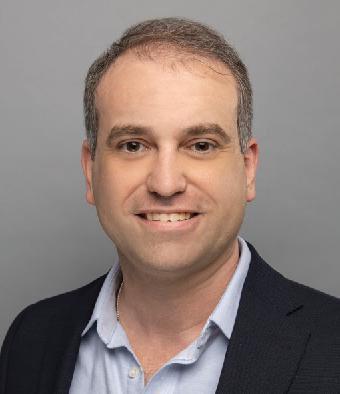
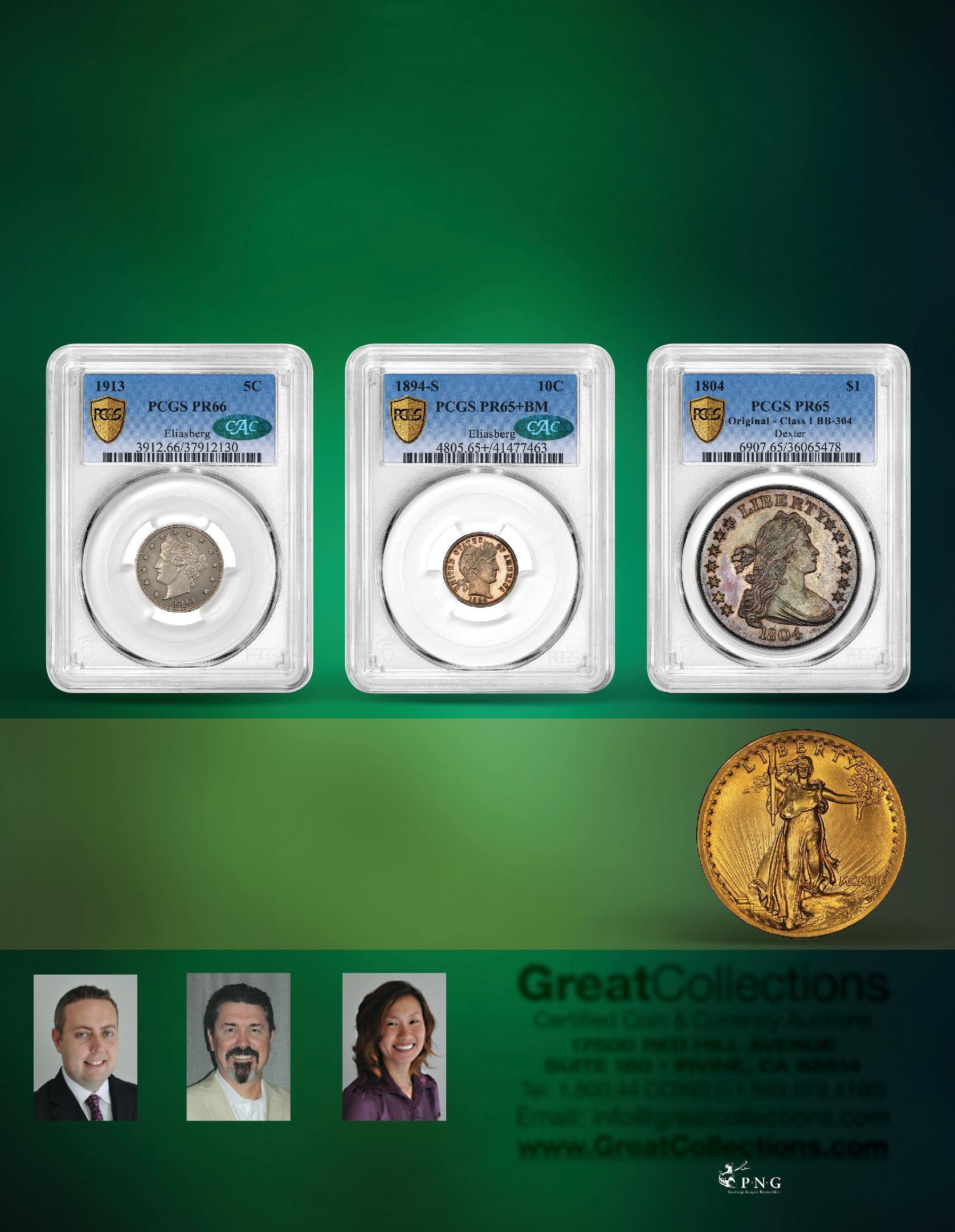
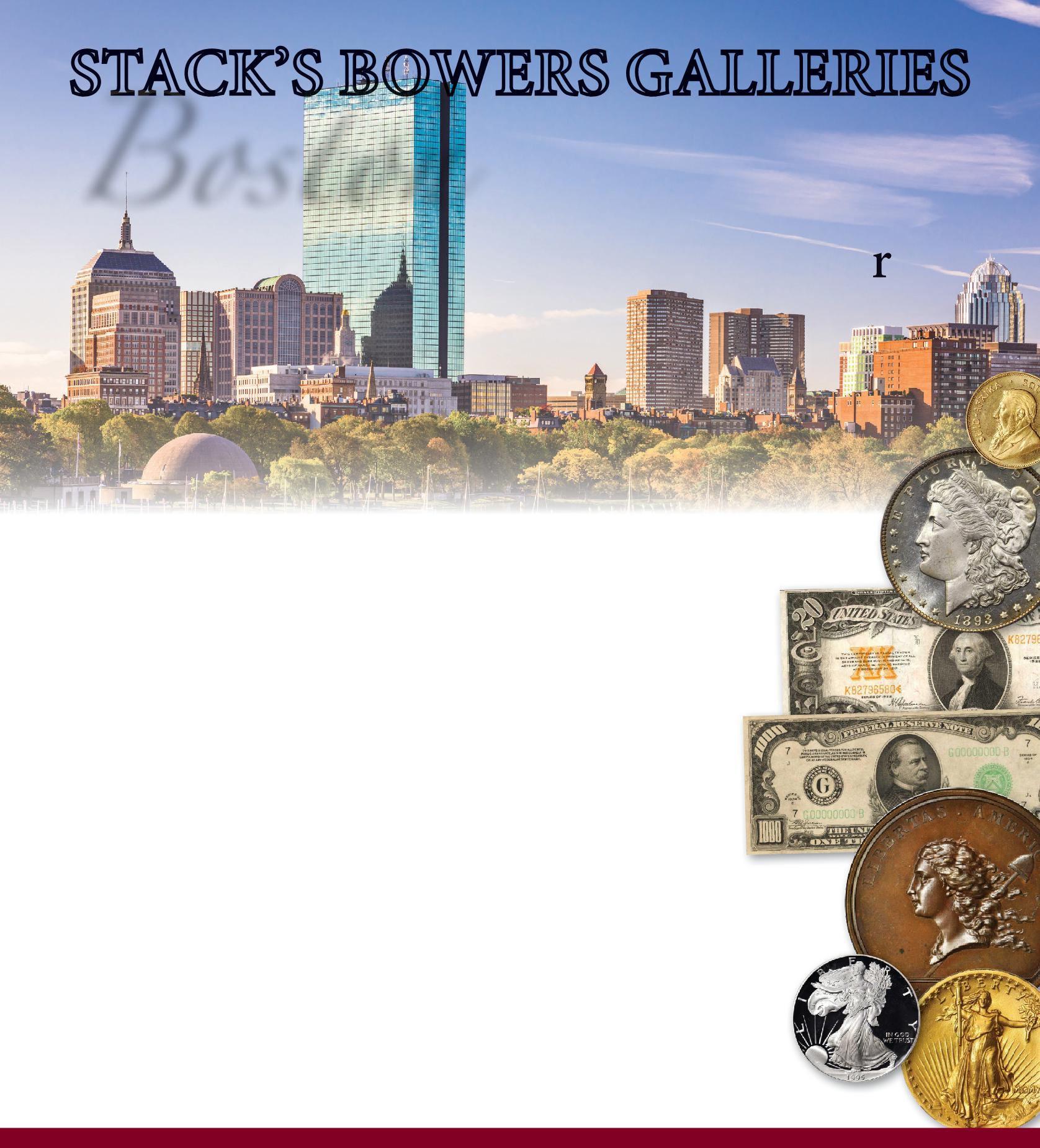


This rare 1866 Liberty Head Double Eagle With Motto, graded PCGS PR67DCAM, is a seven-figure treasure. This single-finest-known specimen was recently acquired by U.S. Coins of Houston, Texas.
7

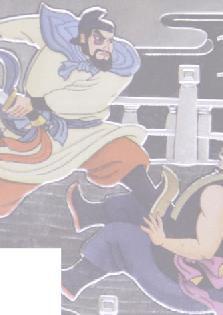
Joshua McMorrow-Hernandez shares some of the highlights from a famous collection that is now up for bids, with proceeds benefiting many amazing charities. 11 Out of the Woodwork: Important Coins
Mark Ferguson reveals some of the most famous coins that have emerged from cabinets and collections with shrouded pasts. 18 Low Ball Sets Within the PCGS Set Registry
Sanjay Gandhi dishes on some of the most popular and challenging low ball coin sets on the PCGS Registry Set. 21 Star


Peter Anthony tells the tale of Song Jiang, a figure from China’s great literary history and one who has taken a place on the nation’s coinage. 27 Collector Spotlight:

Low ball collecting just isn’t the same without Christopher Lane, a collector whose passion for low-grade coins registers high on the numismatic scale. 29 Young Numismatist Digs History
Meet 17-year-old South Texan Jacob Gonzalez, a collector whose passions thrive on Mexico’s rich coinage history. 48
Joshua McMorrow-Hernandez dives deep on low ball coins, which offer collectors an entirely different set of challenges and opportunities than many typically encounter on the PCGS Set Registry. 62 The Full
Doug Winter explains the great rarity and value behind the 1855-D Gold Dollar, a coin notorious for carrying a weakly struck date and seldomly seen with a complete strike.


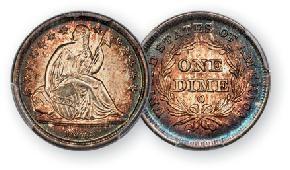
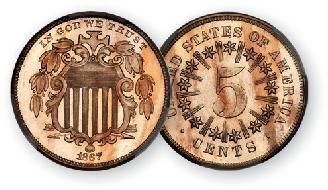

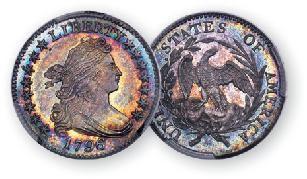



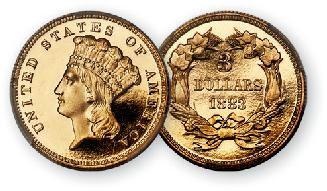
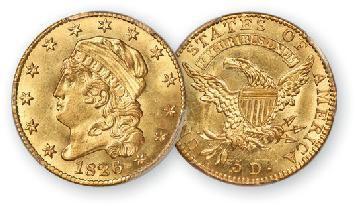
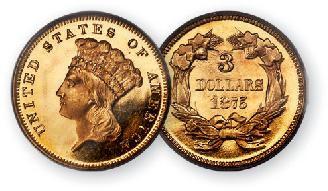



 By Joshua McMorrow-Hernandez
By Joshua McMorrow-Hernandez
One of the largest collections of coins ever offered for public display has made its round to the auction block, bringing with it a slew of rare and even unique collectibles once thought untouchable by the private collecting community. Offered for sale is the Harry W. Bass, Jr. Core Collection, a numismatic cabinet of unparalleled significance and history encompassing over 300 gold coins and more than 100 pattern pieces dating back to the late 1700s. It was assembled by the late Dallas oil baron and beloved philanthropist Harry W. Bass, who died in 1998 at the age of 71. He bequeathed his massive collection

to the American Numismatic Association Money Museum, where it was on exhibit for more than two decades and lured collectors and tourists from all over the nation.
However, trustees of the Harry W. Bass, Jr. Foundation are hoping to further support many Dallas-area charities that were close to Bass’ heart and decided the time was right to liquidate the collection to raise more funds for a variety of causes. The collection could realize as much as $60 million or more. Harry W. Bass, Jr. Foundation Executive Director David Calhoun remarked on the lasting impact the sale of this

the Harry W. Bass, Jr. Core Collection include the 1829 Large Capped
Some of the many highlights from the Harry W. Bass, Jr. Core Collection include the 1829 Large Size Capped Bust Half Eagle graded PCGS PR66+, 1795 9 Leaves Draped Bust Eagle in PCGS MS64, and 1907 Extremely High Relief Inverted Edge Letters Saint-Gaudens Double Eagle boasting a PCGS grade of PR69. Courtesy of PCGS TrueView.

collection will have on the community his organization serves.
“The sale of the Harry W. Bass, Jr. Collection is going to positively impact countless lives in the Dallas area – the place that Harry called home for so many years and was so close to his heart. The proceeds from the sale of the Harry W. Bass Collection will provide tens of millions of dollars to Dallasarea 501(c)(3) organizations that support research, education, health, civics, the arts, science, and so many other causes that enrich the lives of Texans.”
The Harry W. Bass, Jr. Foundation chose Professional Coin Grading Service to grade and encapsulate the coins and Heritage Auctions to facilitate their sale. “This is a truly once-in-a-lifetime opportunity for collectors to add to their collections a number of unique and extremely rare coins that were until recently thought virtually untouchable by private collectors,” remarked PCGS President Stephanie Sabin. “Among the outstanding rarities to be auctioned is the 1870-S $3 Indian Princess, a coin that was noted as a unique strike according to the superintendent of the San Francisco Mint at the time. We are thrilled to encapsulate this treasure and all the others hailing from the Harry W. Bass, Jr. Collection. Our encapsulation of these coins will protect their legacy and value for generations to come.”
The unique 1870-S $3 Indian Princess is graded PCGS SP50. Courtesy of PCGS TrueView.
The 1870-S $3 Indian Princess, a unique rarity graded PCGS SP50, is the undisputed star of the cabinet. The inclusion of this coin provides for the only complete collection of $3 gold, which is a cornerstone of the Harry W. Bass, Jr.

Core Collection. Some believe the 1870-S $3 coin alone could fetch $5 million or even more. However, there are many other incredible treasures up for grabs, among them gems from some of the most advanced sets ever built. These include a U.S. gold type set spanning from 1795 through 1933, a survey of various die states – some unique or among only a handful known, and early U.S. gold varieties.

Among the highlights are a quintuplet of different 1795 Half Eagles, an 1804 Draped Bust Eagle graded PR63, and a 1907 High Relief Flat Rim Saint-Gaudens Double Eagle in PCGS MS65. Gold is not all that glitters in this collection, with a parade of rare patterns including an 1836 Name on Base Judd-60 / Pollock 65 R.1 Dollar in PCGS PR64, rainbowtinged 1875 Twenty Cents Judd-1412 / Pollock 1555 High R.6 in PCGS PR65BN, 1879 Judd-1608 / Pollock 1804 Low R.7 Schoolgirl Dollar graded PCGS PR67CAM, 1896 Judd1772 / Pollock 1989 High R.6 Five Cents in PCGS PR65, and many others.
“The sheer magnitude of rarity ensconced in this collection is simply unmatched,” observed Todd Imhof, executive vice president of Heritage Auctions. “We are not just talking about ultra-rarities like the 1870-S $3, but a virtually complete
collection of all known die varieties of early United States gold coins, a complete collection of gold type coins from 1795 through 1933, and many rare U.S. pattern coins. It’s unfathomable, really, what this collection offers. Heritage Auctions is proud to have the opportunity to offer this amazing collection of coins to the public in what will surely become one of most historic auctions ever held.”
The Harry W. Bass, Jr. Collection commenced with its first sale of the Core Collection September 29, 2022, at the Long Beach Expo in Southern California. Fervent online bidding and standing-room-only crowds brought strong bids, and a repeat is expected at the next auction. For more information about the sale of the Harry W. Bass, Jr. Collection, please visit www.HA.com. To learn more about the Harry W. Bass, Jr. Foundation, check out HBRF.org.
Joshua McMorrow-Hernandez has won multiple awards from the NLG and ANA for his work as a numismatic journalist and editor. He has been a coin collector since 1992 and enjoys all areas of United States coinage and U.S. minting history.


 By Mark Ferguson
By Mark Ferguson
The legendary King of Siam Proof Set is now part of magnificent Tyrant Collection. Image from the Tyrant Collection and courtesy of Ira and Larry Goldberg Coins & Collectibles.
Many famous and important rare coins can be traced back to their origins through their provenance with a reasonable degree of certainty. For example, the King of Siam 1804 Dollar, and the magnificent presentation set it is a part of, can be traced all the way back to the U.S. Mint and U.S. special agent Edmund Roberts who, in 1836, presented the set as a gift from President Andrew Jackson to the King of Siam.

During more modern times in the numismatic world, the King of Siam presentation set had been rumored to exist, but some numismatists were skeptical. In the original version of
their classic 1962 book, The Fantastic 1804 Dollar, authors Eric Newman and Kenneth Bressett wrote a chapter entitled “The Diplomatic Gift Delusion.” The books were being printed by Whitman Publishing in Racine, Wisconsin, when David Spink of London brought the King of Siam diplomatic gift set to the American Numismatic Association convention that year in Detroit to announce the set’s discovery. After the presentation, Ken Bressett literally ran to a phone, called Whitman, and said, “stop the presses!” The chapter was later rewritten with the title, “The Diplomatic Gift Background.”

That was a century and a quarter after the set was presented to the King of Siam, during which time the existence of these coins was only speculation in the numismatic world.
“The Most Famous Provenance in American Numismatics”
Similarly, in a famous 1964 Christie’s auction that took place in London, the firm offered a group of 30 mint state copper and silver coins from the United States that were struck during 1794 and 1795. Among the offerings were several large cents from 1794 as well as half dollars and dollars from 1794 and 1795. Researchers believe the coins were obtained directly from the U.S. Mint in Philadelphia by British collector William Strickland during his 10-month visit to America from September 1794 through July 1795.
Oneofthesecoins,a1794Dollar,laterbecamepartoftheD. Brent Pogue Collection. Graded PCGS MS66+, the dollar was auctioned in 2015 by Stack’s Bowers Galleries in cooperation with Sotheby’s, realizing $4,993,750. The catalog stated, “The Most Famous Provenance in American Numismatics.” Also emphasized was the coin’s “Intact Provenance to 1794.” The coins were consigned to the 1964 Christie’s sale by “Major the Lord St. Oswald, M.C.,” a descendant of William Strickland. Prior to the 1964 sale, the collecting world was unaware of this group of high-grade early American coins. Known as the Lord St. Oswald 1794 Dollar, the coin was sold again in 2021 by Heritage Auctions for $6,600,000.

For example, James Vila Dexter, famous for his ownership of the “Dexter Dollar,” one of 15 known 1804-dated dollars, was an advanced collector who was most active in the 1880s. He kept detailed inventory books of his coins. One of his extremely rare coins was a 1798 Small Eagle Half Eagle. Per PCGS CoinFacts, just seven examples of the gold coin are known today. Dexter’s inventory listing stated, “1798 13 stars (5 facing). Rev small eagle. Not in U.S. Mint [collection]. Very rare, only 4 known. Cut on edge. $51.”
The Lord St. Oswald example of the 1794 Flowing Hair Dollar sold for $6.6 million in 2021. Courtesy of PCGS TrueView.

Most important early American coins can be tracked back through time and previous ownership through auction catalogs. Coin descriptions in the catalogs normally list prior ownership, or provenance. Additionally, coins can often be identified and compared through “plate matching.” But prior to the introduction of photographs and in-depth catalog descriptions, identifying specific coins can be difficult. Researchers must look for other clues.
The 1804 “Dexter” Dollar is unmistakable from its other 1804 Class I Draped Bust Dollar cohorts. This one has a small “D” inscribed in one of the clouds on the reverse of the coin – John Vila Dexter’s calling card. Courtesy of Stack’s Bowers Galleries.
“Cut on edge” is an identifying clue, especially with only seven examples known. But in this case, it’s not conclusive. Photographs of two examples of 1798 Small Eagle Half Eagles are provided on the PCGS CoinFacts page and grade AU55 and AU53. It turns out that both examples have minor edge bumps. The AU55 coin, formerly part of the Pogue Collection, shows a minor edge bump at the top of the reverse, while the AU53 coin shows a small edge bump on the left side of its reverse.
Further research, such as examining the other examples of the 1798 Small Eagle Half Eagle or photographs of them, could eliminate more of them from consideration as the Dexter coin. If the Dexter coin is one of the two illustrated on the CoinFacts page, it’s possible that one of them could be eliminated by piecing together its provenance. There was no auction of James V. Dexter’s collection. It was sold privately, making later ownership of his coins difficult to track back to him. That is why James V. Dexter was primarily known for owning an 1804 Dollar, now known as the “Dexter Dollar,” and not for the rest of his collection.

As an aside, the AU55 Pogue example of the 1798 Small Eagle Half Eagle, which could very well have been the Dexter coin, sold at auction in 2015 for $1,175,000. This is a great example of how far coin prices have advanced since the 1880s era, when Dexter purchased his example for just $51!

Was this 1798 Small Eagle Half Eagle, graded PCGS AU55 and sold as part of the D. Brent Pogue Collection, once in the cabinet of John Vila Dexter? Courtesy of PCGS TrueView.
Earlier this year, the PCGS Price Guide team was contacted by PCGS Registry collector James Swan. Mr. Swan was astounded to learn that a coin he previously owned was sold in a January 2022 Heritage Auctions sale for more than 15 times the price he paid for it in 2001! The coin in question is the second-highest-graded 1796 No Stars Quarter Eagle known. PCGS estimates there are up to 10 No Stars Quarter Eagles that grade mint state. The former Swan coin grades PCGS MS62+. PCGS has graded just one finer, at MS65.
Jim Swan purchased his example from the late dealer Larry Whitlow who came across the coin at a Whitman Coin & Collectibles Expo in Baltimore. Swan remarked that “He [Whitlow] was amazed that the coin was really ‘new,’ as he called it. At that time few dealers had ever seen an actual mint state 1796 No Stars Quarter Eagle.” Swan paid $140,000 for the coin in 2001 and then sold it privately to well-known collector Oliver Jung in 2002 for $180,000. Jung’s coins were sold by American Numismatic Rarities in July 2004 when the coin realized $345,000. It then became part of the Samuel J. Berngard Collection and was sold by Stack’s Bowers in July 2008 for $488,750. The coin was purchased by Bob R. Simpson, from whose collection it was sold in the January 2022 Heritage Auctions sale for $2,160,000!
WhilethatpricewasastoundingtoMr.Swan,hismainpoint in contacting us was the lack of a pedigree for this important coin. After he purchased it, he scoured old auction catalogs trying to find it, but came up dry. He tried to “plate match” the coin by comparing photographs in auction catalogs but couldn’t identify the piece. As part of the provenance in the Stack’s Bowers Galleries sale of the Berngard collection, the catalog description stated, “James Swan U.S. Type Collection, earlier pedigree unrecorded.” Prior to Whitlow’s discovery of this coin at the 2001 Baltimore show, we wonder, where was this important coin hiding?
Digging deeper in 1796 No Stars Quarter Eagles, famous collector and researcher Harry Bass “re-discovered” that two reverse dies were used to strike these coins. In his extensive research on this coin issue, he found just one reference to the two die varieties – a mention made in the personal notes of numismatist Edgar H. Adams regarding an example that was sold in the William F. Gable Collection sale of 1914 by S.H. Chapman. The Chapman catalog description did not mention this die variety. Bass stated, “Evidently, Mr. Adams was the only person who to this day had recognized the two different reverses.”
The tell-tale diagnostic is that on the short-lived first issue of the 1796 No Stars Quarter Eagle (today known as BD-1 or Bass-Dannreuther 1) is the length of the arrows on the reverse that are held by the eagle’s talon. They extend nearly to the “I” in UNITED, whereas on the “more common” variety (BD-2), the arrows are shorter, extending only about to the second leg of the “N” in UNITED.
Mr. Bass diligently searched for several years to find an example of the BD-1 variety with the longer arrows. Finally, in 1972, his dealer friend Mike Brownlee brought a 1796 No Stars Quarter Eagle to Bass’s office merely to show him, as a matter of interest, what he had just purchased. Bass later wrote, “You can imagine his surprise when I let out a loud yell

‘This is it, this is it,’ for he did not know what I was talking about. I proceeded to explain to him that the coin in my hand was a specimen of the reverse die referred to by Edgar H. Adams in his private notebook and photographed in the Chapman-Gable auction catalog of 1914.”
The scarcer BD-1 is believed to have been from the first mintage of 1796 No Stars Quarter Eagles, of which 66 coins were delivered on September 21, 1796. Bass wrote, “There is a large vertical die crack running through the coin as well as a smaller and fainter lateral die crack running from 9 o’clock to the midpoint of the coin. Obviously, the first reverse die quickly broke, as a result probably of having been improperly prepared.” An additional 897 examples of the 1796 No Stars Quarter Eagles, presumably with the “BD-2” reverse, were delivered on December 8, 1796, for a total mintage of 963 coins with the No Stars obverse.

Like Harry Bass, die-variety collectors and researchers get lucky once in a while in their quest to “cherry pick” scarce and rare varieties. While it’s a rare occurrence, unrecognized die varieties and die marriages have been discovered during recent times. Such an event occurred in 2020 when a new die marriage of an obverse and reverse die combination was
discovered for a 1795 Half Dollar. Previously covered by PCGS’s Joshua McMorrow-Hernandez in 2020, he wrote, “Notably, it is the first new die marriage discovered on a 1795 Flowing Hair Half Dollar in at least 91 years.”
Professional numismatist W. David Perkins submitted the newly discovered die marriage for this coin to PCGS which confirmed the coin as a new variety, “Overton 133.” PCGS recognized this discovery by printing “Discovery Coin” on the coin’s encapsulated label. Perkins stated, “Only three Flowing Hair Half Dollars have been granted new Overton variety designations in the last 50 years, and all three are dated 1794.” He goes on, “The last 1795 Flowing Hair Dollar die marriage was discovered somewhere between 1881 and 1929.”
In January 2005, Heritage Auctions sold a rare, high-grade 1839/8 Type of 1838 Liberty Eagle. Graded PCGS MS66 and described as “The Finest Known,” the coin sold for $402,500. Again, that was in 2005 and the coin’s auction price would undoubtedly be much higher today.
Quoting from the Heritage Auctions catalog description, “This is one of the most spectacular and important coins in
this incredible auction. The team of catalogers all expressed amazement when this coin arrived in our offices. It simply shouldn’t exist, not in this stellar grade.

Examine the surfaces, the strike, the radiant luster, and any collector or dealer will agree that this piece is stunning. It is, of course, the finest and only example of this date graded this high by PCGS [...] The cataloger recalls discussing the secondfinest example of this issue when it was sold in the Rasmussen Collection by Superior Stamp & Coin in February of 1998. At that time the present coin was not publicized and that raw MS65 coin they offered was assumed to be the finest known of the date and two-year type.
Nearly a year later, the present coin popped up out of the fabric of numismatics, and quickly assumed its rightful place on the highest thrown [sic] awarded by PCGS [...] of this type, a coveted and well deserved MS66. While there is always the possibility of a finer example than the present specimen, it would seem quite remote and virtually impossible for such a coin to have remained hidden from numismatic discovery.”
As illustrated here, rare and important coins have turned up long after they were minted. Some 125 years passed before the King of Siam presentation set was discovered by numismatists. The Lord St. Oswald coins came to light after nearly a century and three-quarters. Jim Swan’s 1796 No Stars Quarter Eagle,
the second-finest known, was brought to light two centuries after it was minted. Harry Bass “re-discovered” a second die variety for the 1796 No Stars Quarter Eagle 58 years after Edgar Adams noted it, which was more than a century after the coin issue was struck. A new die marriage was discovered for the 1795 Half Dollar two and a quarter centuries after the coin was struck; and it took well over a century and a half for the finest-known 1839/8 type of 1838 $10 gold coin to make its presence known to the numismatic world.
Based on these few examples, and there are many more, the likelihood of more numismatic treasures turning up in the future is high. Finding such a treasure will involve luck, but if you want to embark on such a treasure hunt, studying die varieties and examining thousands of coins at shows and auctions will exponentially boost your chances of getting lucky!
Mark Ferguson began buying and selling coins in 1969. He graded coins for PCGS between 1986 and 1990 and currently serves as the company's senior price guide consultant. He’s a numismatic researcher, writer, appraiser, and advisor, and he authored The Dollar of 1804: The U.S. Mint’s Hidden Secret.


1890 Morgan Dollar, PCGS PO01.
The PCGS Set Registry went online in 2001 with a variety of sets involving some of the finest coins around in the highest grade known. However, in the years since, another aspect of collecting has gained steam on the Set Registry: low ball sets. Low ball coins have been referred to as a “slick,” or “slicks,” “culls,” “pocket pieces,” etc., and all of these terms essentially are describing coins with smooth surfaces devoid of most visible design details. In low ball collecting, the less you can see of the coin, the better off you are in terms of winning an award within the Set Registry. The first low ball sets hit the PCGS Set Registry on September 13, 2007, and included three low ball sets.

For those of you who are not familiar with these types of sets, the lowest-graded examples of coins are sought to create sets with the lowest overall grade-point average. In the scope of a low ball set, the “finest” grade a member may score PO01 or Poor-1, which is defined by PCGS Grading Standards as “identifiable as to the type, date, and mintmark.” Then we can go up the grading scale to the next grade being an FR02 or Fair-2, AG-3 or About Good-3, and so on.
A look at the U.S. Coin Forum on PCGS.com shows that one of the most controversial comments was this one: “Buying lowball [sic] coins are [sic] a mistake. They seem to be a hyped collectible that was promoted in this forum. In a few years the

hype will have worn off and the promoters will have exited.” Among the rebuttals was this one from another member: “Nonsense, the appeal of worn coins will always exist within this hobby. It harkens [sic] back to collecting as kids for those old worn coins in change.”
Some low ball sets have taken multiple decades to complete. Picture anyone viewing one MS67/MS68 Morgan Dollar after another within the finest PCGS Registry Set displayed online. Each example is almost as perfect as the next, which is quite an accomplishment in numismatics and anyone would be in awe looking at these near-perfect examples in a single set. The price tag to assemble a collection of such superlative coinage may be daunting for the average collector. “Two roads diverged in a wood, and I – I took the one less traveled by, and that has made all the difference.” This snippet of a poem titled “The Road Not Taken,” written by Robert Frost, may potentially resonate with the low ball collector.
The barriers to entry for low ball sets are lower than establishing the finest high-grade sets, as these sets are the polar opposite of trying to find the highest-graded examples to collect and finding the best of the worst may prove to be a lifelong challenge. Collectors don’t necessarily have to embrace perfection within coin collecting all the time. What really is “perfect” in this world? Maybe a slice of piping-hot thin, foldable New York City pizza? Or perhaps a hefty, cheesy Chicago deep-dish slice? To each their own!

If one were to Google the phrase “science and charity,” one of the first entries returned is a painting by Pablo Picasso. This is a work by him that is classified under the category of “realism.” At some point in Picasso’s career, he possibly got bored with the norm for the sake of crafting the finest imitation that he could produce. In the early 1900s, Picasso is known for being one of the pioneers of a technique known as “Cubism.” This new movement was a deviation from the norm and participants within the first PCGS low ball sets listed are similar in some ways. These new collectors helped build the PCGS Set Registry into what it is today, among them the 2,800+ (and counting) low ball Registry Sets built by our fervent members. We thank you! Collect whatever you want to collect, and remember – there’s a set for almost anyone to build at PCGS! Happy Collecting!
Sanjay Gandhi is a senior content manager at PCGS. His knowledge base consists of a wide variety of world coinage, and he has a great appreciation for toned coins that display vibrant colors. In addition to contributing content to PCGS Rare Coin Market Report, he also assists collectors with the PCGS Set Registry.

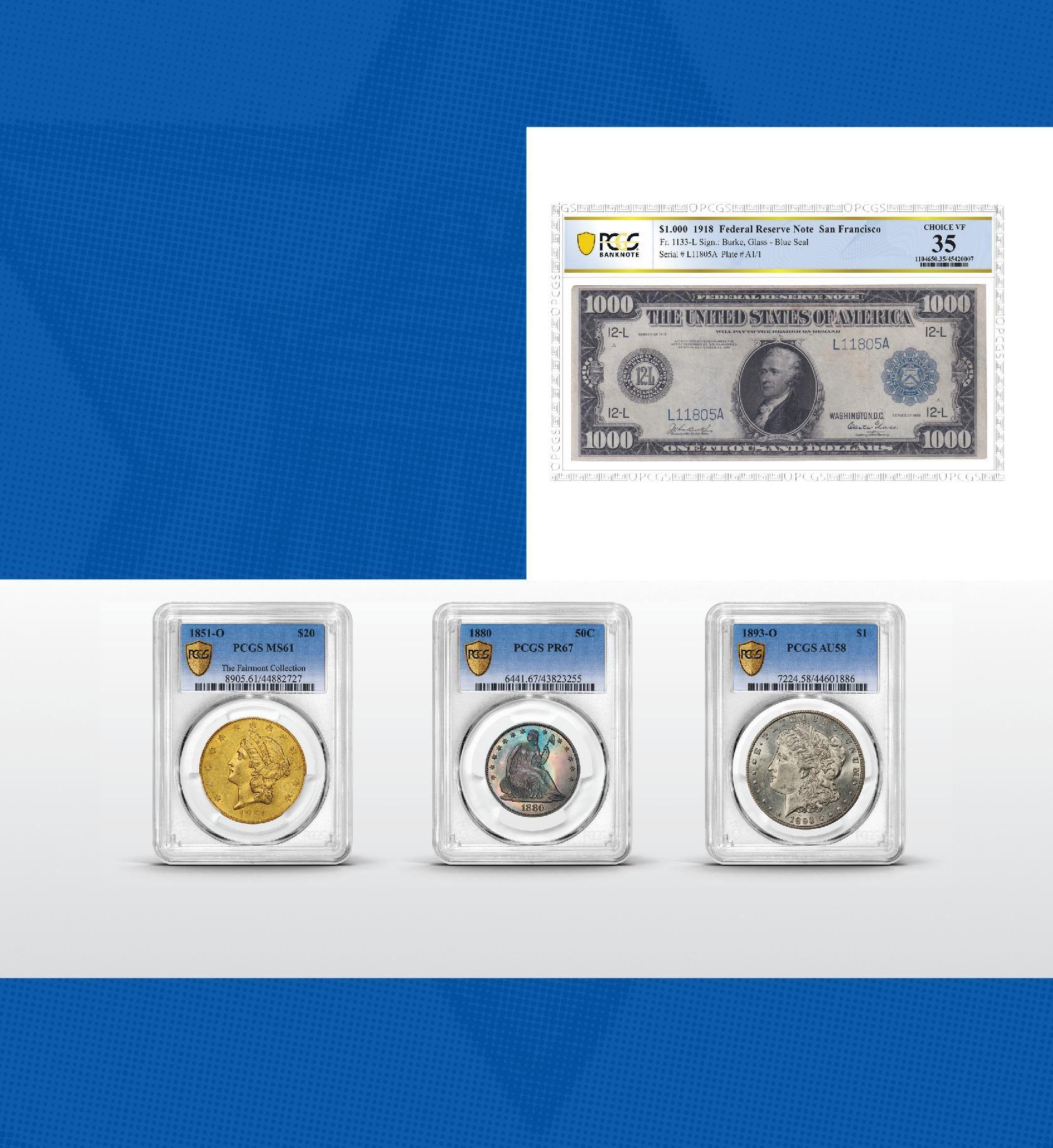

A thousand years ago a court clerk in China, or rather an ex-clerk, watched the goings on in a village through a thicket of bamboo. The minutes crawled by for Song Jiang, the ex-clerk nicknamed “Timely Rain” for his helpfulness to those in need. Others called him, “filial and righteous third son.” Loyal to his family he proves to be in the book Outlaws of the Marsh. For Song Jiang to be caught here would mean certain execution.
Outlaws of the Marsh, attributed to the writer Shi Nai'an, is considered to be one of the four great classics of Chinese literature. It follows the events of a rebellion against the Northern Song Dynasty empire (960 A.D. -1160 A.D.). The Song government encouraged the growth of arts and literature among the educated but was severely hard on the common folk. Some Western readers have compared Song Jiang’s band of outlaws and rebels to Robin Hood. Or, maybe, another fictional revolt that begins, “A long time ago in a galaxy far, far away…”
How this well-intentioned former civil servant could find himself hunted like a deer in the forest is a bit complicated. The best explanation may be human nature. People typically assume that others will act like they would in like circumstances. That was the sticking point, so to speak, that stumped Song’s would-be blackmailer. She knew he had been offered 30 gold coins as thanks for helping someone. A letter she found revealed that. What she couldn’t believe, or accept, is that he turned down the offer — inconceivable!
What would the coins have looked like? During the Song Dynasty (no relation to clerk Song’s family) most Chinese coins were cast into round discs from molten bronze poured into molds. A distinctive square hole is in the center. The term for them today is “cash coins.” Several modern Chinese coins mimic this distinctive shape. One example is the 1990 10 Yuan Vault Protector. It is struck in one ounce of .999 silver and is 40 millimeters in diameter. The story leaves unsaid the details of the 30 gold coins — they could even be foreign coins

that arrived in China via the Silk Road trade.
What might Song Jiang have looked like? His “image” is on one coin. In 2009, a 150 Yuan proof .999-fine gold coin that is 23 millimeters in diameter and weighs in at one-third of an ounce was struck by the People’s Republic of China. The coin is colorized and Song is shown wearing a red cape and holding a pennant. Behind him are the kind of boats the rebels would have used as they hid from the military in a marsh. Its stated mintage is 30,000.
and whistles fill the night behind him. He crests a hill and spies another village. “Oh no! It is Circular Road Village,” he groans. This remote town, surrounded by mountains and water, has only one road in and out. Song Jiang is cornered!
A grove of trees in the town beckons. Within it, Song finds an ancient temple closed behind iron gates. Too panicked to care about noise, he pushes them open and runs inside. He can hear the posse outside. A policeman’s voice that he recognizes declares, “He must be in the temple. Look there.”
Dozens of men jam through the temple entrance. “Search everywhere. I know he is here!” With no time to spare the desperado pushes aside a heavy fabric covering and slips into the temple shrine. Inside, Song wedges himself behind an idol and curls up.
“I’m a dead duck. Please, oh please, spirits protect me,” Song silently prays. At first all the men pass the shrine by, but one of the policemen walks up to it. He raises the curtain with his spear tip and thrusts a torch forward.
Instantly, the firebrand flares and an ember flies into the constable’s eye. He drops the torch, which promptly goes black. The policeman hobbles outside and announces, “He’s not in there. Where could he be?”
A 2009 2,000 Yuan 5-ounce .999-gold Outlaws of the Marsh series, “The Clever Capturing of the Royal Birthday Gifts.” Courtesy of Peter Anthony.

Song Jiang and his blackmailer – a concubine forced on him by her impoverished mother after he pays for her father’s funeral out of charity – trade loud threats. Unwanted and ignored by Song Jiang, she needs the money to run away with her boyfriend. A knife is drawn. Now, as Song frets and lurks among the bamboo trees the ill-fated blackmailer lies dead. By Song Dynasty law if one member of a family cannot be punished for a crime then a close relative must serve the sentence instead. Song Jiang rightfully fears for his father’s and brother’s safety.
Under cover of night Song Jiang sidles up to the back entrance of his old home. He knocks softly. A curtain opens and his brother Song Jing stares out at him, astonished. “Why did you come here?” Jing whispers. “The county sends two constables every day to hang around and watch us. We’re not allowed to leave. As soon as the documents arrive, they’re going to arrest father and me and put us in jail until you’re captured. There are nearly 200 soldiers patrolling the neighborhood day and night. Get out of here! You have no time to waste.”
The fugitive slips back into the shadows. The Moon is hazy and there is little light. He retreats along a seldom-used path until, suddenly, there are shouts, “Stand where you are, Song Jiang.” Immediately, the wanted man turns and runs. Yells
“We will find him in the morning. He can’t get out of this village even if he grows wings,” replies the second officer.
At that moment a soldier appears to announce, “The rat must be in here. We found his handprints on the dusty gate!”
“O.K. Let’s search again and don’t miss anything.”
Once more the group carefully combs the building’s interior. Finally, one constable says, “He’s in the shrine. He has to be.” Half a dozen soldiers follow him over to it, but just as he lifts the fabric to peer inside a gust of wind puffs out and extinguishes all the torches.
“This place is haunted, let’s go,” the soldiers nod in the now pitch-black room.
One constable, though, has not had quite enough. “Let’s just poke around a little with our spears before we leave?” he says.
At this point in the story, I picture Song Jiang waving his hand and telling the stubborn policeman, “This is not the shrine you are looking for.”
What actually happens is that no sooner do the lawmen step toward the shrine then a howling, biting black cloud of sand and gravel grit blows in from the rear of the hall. The entire building shakes under its fury. All the men’s hairs stand on end. Panicked, one yells, “Run — the temple god is angry!”
Inside his shelter Song Jiang chuckles.
The frantic soldiers flee and some fall. “Save us,” they cry. One of the policemen turns back. Several of the men’s uniforms are tangled up in tree roots and they cannot break
Here is the 2010 10 Yuan, 1-ounce .999-fine silver Outlaws of the Marsh series “Yong Shi selling his saber.” There is also the 2011 10 Yuan 1-ounce .999-fine silver Outlaws of the Marsh series “Hua Rong shoots a wild goose on Mt. Liangshan.” Courtesy of Peter Anthony.

loose. The constable cuts them loose and all gather together in the street.
“We woke up a powerful spirit in there. Let’s get back to the village. We will get that rascal when it’s light!”
After the men leave Song Jiang comes out from the shrine. Grateful to be free, he still has no idea how to escape the village. At that moment two boys dressed in green walk up to him. “Star Lord, our queen wishes to meet with you,” they announce.
Song is puzzled. Star Lord? Who is this Star Lord?
The boys urge him to hurry; the queen is waiting.
Speechless, he is more surprised when two girls, also dressed in green, step out from the shrine he was just hiding in. He recognizes them as Earth Fairies. “Star Lord Song, you must come along,” they announce as bird songs float like music through the air.
Song tries to explain he is just an ordinary person, but the fairies address him again as Star Lord. “The Queen invites you to her palace.”
They all leave through a door at the rear of the temple. Outside there is a broad garden. The night is no longer gloomy. Stars twinkle in the sky.
“I should have hidden back here,” thinks Song Jiang.
The group follows a smooth road that winds ever higher. A bridge of blue stones arches over a babbling brook that sparkles in the moonlight like silver. Trees and flowers unknown to Song surround them.
At the palace door there are dragon and phoenix designs carved into the flagstones. Song falls to his knees, and kowtows as he softly declares, “Please forgive this commoner, your Celestial Highness. I beg your Heavenly mercy and forgiveness.”
Led inside, his audience with the Mystic Queen is not lengthy. The fairy maidens bring him sweet dates and wine. Awkward, he eats three and then hides the date pits in his hand. After three cups of wine, Song Jiang tells the Lady that he cannot drink more. Understanding, she orders that “The Three Heavenly Books” be presented to Star Lord. At last, Song Jiang realizes who he is and that he has existed before.
A young man brings the books out on a jade tray. They are quite small, miniatures really, so Song Jiang tucks them inside his sleeve. Then the queen explains his mission and that he is to never show the books to anyone except another divinity. She concludes with, “Complete your mission and you can return
In 2010 there was issued a 2,000 Yuan, 5-ounce .999-fine gold Outlaws of the Marsh series “Third Attack on the Zhu Family Manor” piece. Courtesy of Peter Anthony.

to Heaven’s Purple Palace. Fail and you will be condemned to where I cannot save you. For now, you are still a mortal, and we cannot remain together, so farewell.”
The fairies walk Song out as far as the blue stone bridge. Then one remarks, “Tomorrow you will escape your pursuers. Do not be afraid. Oh, look Star Lord, two dragons play together.” Song leans over to see this when the girls suddenly push him over the side.
He wakes up in the shrine. “Ah! It was but a dream,” he sighs as he stares up at the Moon through a window. Just then he notices that something is in his clenched hand; three date pits. Song reaches into his sleeve and, sure enough, pulls out three small books wrapped in silk.
Since at least the early 1500s Outlaws of the Marsh has been one of the most-read books in China. Every chapter ends with a cliffhanger, and, besides Song Jiang, the book presents readers with a cast of dozens of memorable heroes and villains. In 2009, when China Gold Coin issued a coin with Song Jiang on it, it also released four more coins that feature other characters, all colorized.
For 2009, besides the round third-ounce Song Jiang gold coin, there is a five-ounce rectangular gold coin (mintage 800), a five-ounce rectangular silver coin (mintage 10,000), and two one-ounce 40-millimeter round silver coins (mintage 60,000 each).
For 2010 the same format: a five-ounce rectangular gold coin (mintage 900), a five-ounce rectangular silver coin (mintage 12,000), a third-ounce round gold coin (mintage 35,000), and two one-ounce round silver coins (mintage 70,000 each).
2011 is the final year of this short series. It finishes with a pair of spectacular coins: a 1-kilogram gold coin that is 90 millimeters in diameter (mintage 200) and a 1-kilogram silver
coin that is 100 millimeters in diameter (mintage 10,000). Both are titled, “Great Gathering at the Hall of Loyalty and Righteousness.” As in prior years there are also a five-ounce rectangular gold coin (mintage 900), a five-ounce rectangular silver coin (mintage 12,000), a third-ounce round gold coin (mintage 35,000), and two one-ounce round silver coins (mintage 70,000 each).
Amazing it is, but there is something that separates Song Jiang from Yoda, or Luke Skywalker, or even Robin Hood: Song Jiang really lived! Outlaws of the Marsh is based on an actual revolution. The official History of the Song states, “Song Jiang, a bandit from Huainan, led a military attack on government forces in Huaiyang. The Emperor sent troops to put down the uprising as well as apprehend the bandit leader. Song Jiang then attacked the region just east of the capital and Hebei before moving to the borders of Chu and Haizhou. The Emperor ordered Zhang Shuye, the Prefect of Haizhou, to offer Song amnesty.”
And that is how the book concludes, with Song Jiang and his followers laying down their weapons. Today, we can relive their adventures through books, films, and 17 outstanding modern Chinese coins.
Peter Anthony is a PCGS consultant on modern Chinese coins and is the author of The Gold and Silver Panda Coin Buyer's Guide 3, a two-time Numismatic Literary Guild winner. He is also the publisher of China Pricepedia, a monthly journal and price guide for modern Chinese coinage.

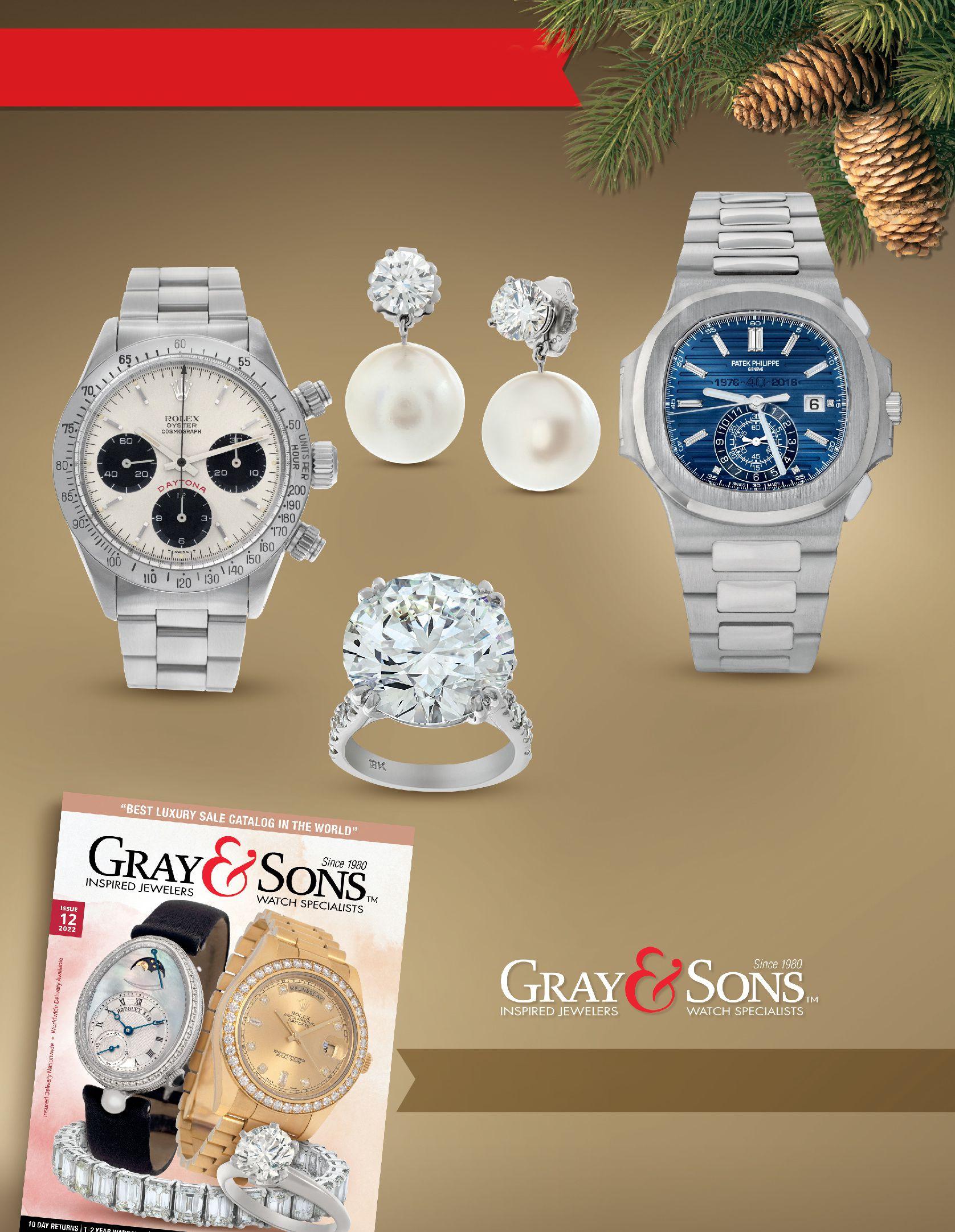

•
•
•
•
•
• On-Site Grading by PCGS
• Professional security by Positive Protection, Inc.
• diverse auctions
• Large, diverse auctions by Heritage and Legend Auctions
• PNG Day Wednesday
• Educational programs
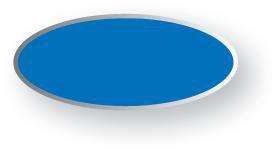
• Special Exhibit of Major Rarities by top collectors
• Early Bird passes and Pre-Show Registration available online @ www.CSNS.org
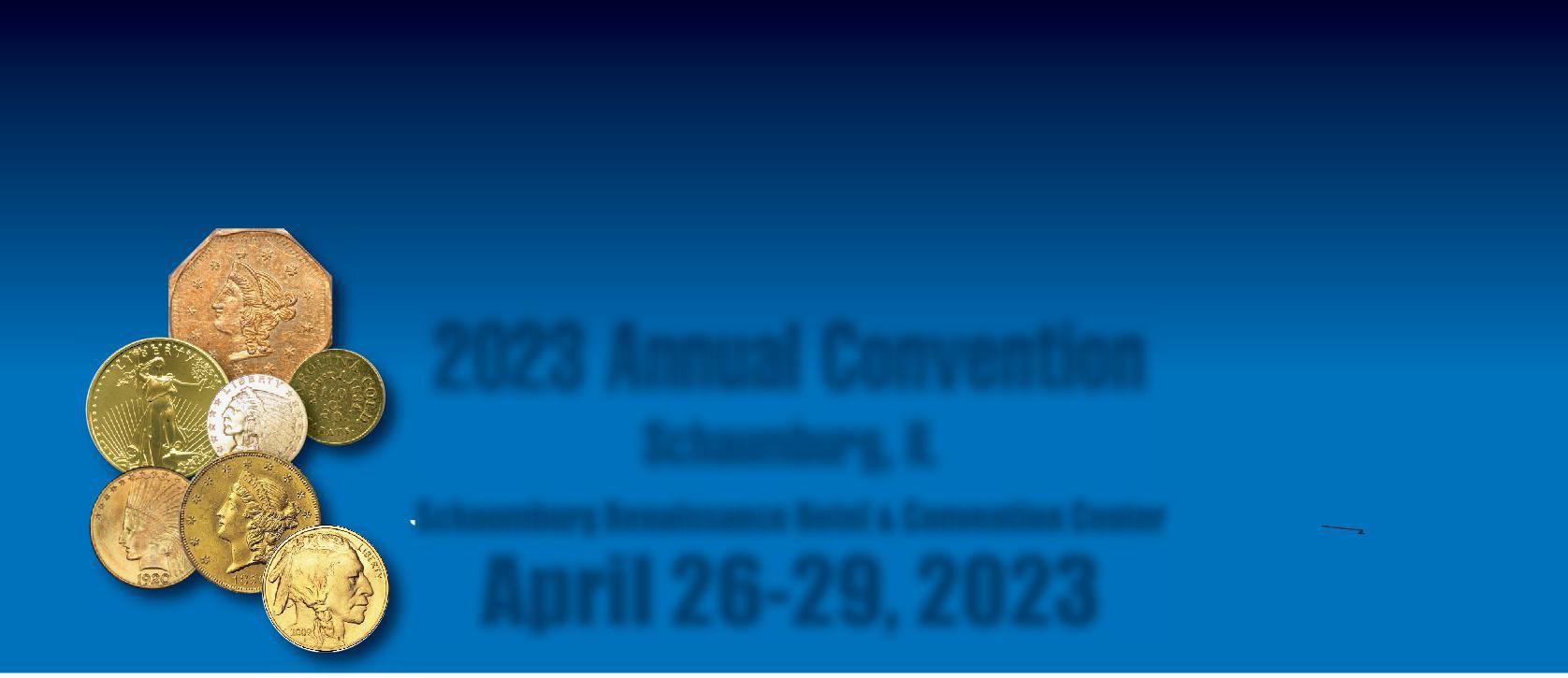
• New Management, Dealer and Collector friendly

• Free hotel guest, dealer, and visitor parking
• Several hundred nearby restaurants
Christopher Lane has aimed high in numismatics by building some of the most challenging low ball sets around. Lane,whoselowballpassionscompelledhimtobuildcomplete sets of coins in the lowest-possible grade obtainable, began his numismatic journey many decades ago as a six-year-old who emulated his older brother Bob, who also collected coins.
“I started collecting coins because my older brother was collecting Mercury Dimes. So, being six years old and not having a bunch of disposable income, I started with Lincoln Cents. This evolved to Indian Cents years later.” He said low ball collecting didn’t arrive on the scene until decades afterward. “I always admired coins that were completely worn out. Something that to this day still holds an allure no matter what the coin is.”
Pursuing low ball coins can be just as challenging as seeking top-grade coins, and sometimes even more so, as is the case with modern coins. It’s that thrill of the chase in finding those tough pieces that appeals to Lane. Another aspect that he appreciates is the unique combination of color and eye appeal that he finds unique to low ball coinage. “Some Draped Bust Quarters, for example, show a beautiful black / grey / silver contrast on the obverse when they are in the Poor and Fair grades. This is not a look found in higher grades!”
Lane has been working on many sets, including those involving Indian Cents and Liberty Seated Quarters. He joined the PCGS Set Registry years ago and is chasing many goals, including one of the crown jewels of his cabinet: the 97-piece Copper, Nickel, Silver Type Set Low Ball. “This is probably one of the more challenging sets, as it has some coins which didn’t circulate all that much – coins that were pulled from circulation almost immediately due to being
This 1864 With L Indian Cent is graded PCGS PR01 and one of low ball collector Christopher Lane’s prized numismatic possessions. Courtesy of Christopher Lane.
unique or one-year type coins.” Among these is the 1883 “NO CENTS” Liberty Nickel. “Right now, there are only three examples graded PO01!”
He added that another tough type coin is the Copper Nickel Indian Cent, issued from 1859 through 1864. “The 1859 Indian Cent is a one-year type coin with only six graded PO01. The 1860-through-1864 Indian Cents are way tougher – there are only two coins graded by PCGS in PO01 among thesecopper-nickelcents!”Laneidentifiedanotherchallenging type coin – one that, “Dare I say in the top five of tough low ball coins,” he declared. “That’s the Three Cent Nickel. With 27 different dates to choose from, you’d think there would be a large supply to choose from. Well, that would be incorrect; PCGS has only graded two PO01 out of the entire series –a single 1865 and 1866, period!”
Indeed, Lane’s low ball type coin set has proven a hill to climb. “Chasing coins for a low ball set is no different than any other quest in numismatics, with one big difference: dumpster diving – sometimes hours spent going through dealers’ junk boxes and bargain bins where the majority of the coins are a dollar or two…” He continued, “Chasing a collectible is the age-old quest that every collector has experienced, whether it’s baseball cards, stamps, pottery, old cars, barn finds, etc. This is the thrill that every collector, young or old, experiences.”

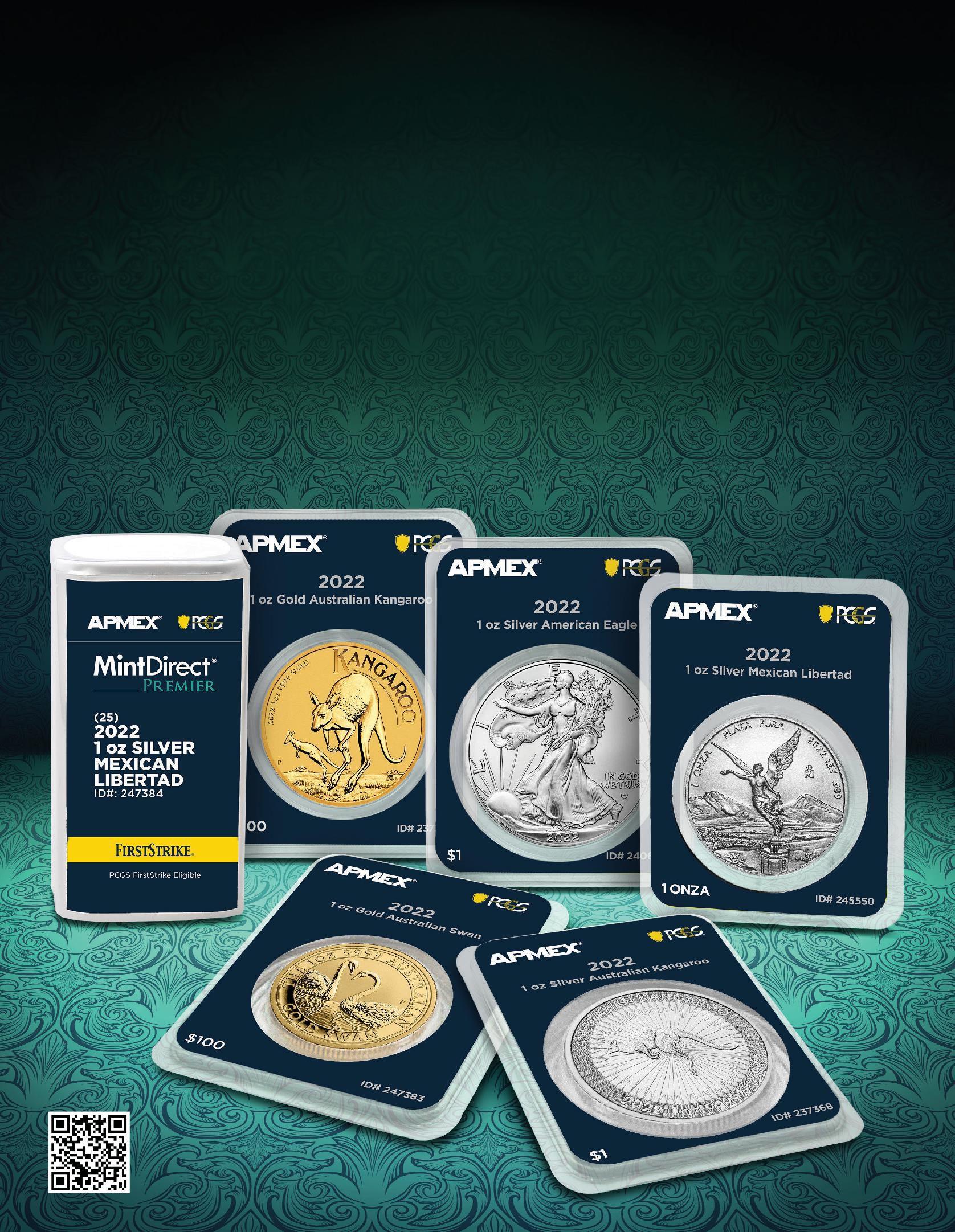
My name is Jacob Gonzalez, and I am a 17-year-old numismatist from South Texas. Currently, I collect a variety of Mexican coins spanning from the early 1500s Colonial period to the dawn of the 20th century. Mexican coins offer a wide range of enticing characteristics, such as rich history, beautiful designs, and extreme rarity at reasonable price points for all collectors. Recently, a surge of new collectors interested in this area of numismatics has resulted in rising coin prices. However, the full potential of many of these coins has not yet been reached.


I got my start in numismatics at age 13, when I would dig through the many drawers in my grandmother’s house looking for some “hidden treasure.” I had located a little leather pouch and inside was a variety of early 20th-century U.S. coinage. The unfamiliar coins piqued my interest, and I began to research each type. After going down what I could only describe as a rabbit hole, I was hooked on coins. I found out that there was a local club, The Hidalgo Coin Club, near me, and I began to actively attend their meetings and shows. After two years of collecting U.S. coins, I began to realize how extremely hard it was to assemble a decent collection as a close-to-broke young numismatist. After exploring a variety of options, I came across Mexican coins.
It is important to note that Mexican coins span almost five centuries' worth of history. During this time, a large variety of coin designs and types were minted, making this area of numismatics quite large. As a new collector of Mexican coins, finding out about all these different coins was like sensory overload. I had a wide variety of coins to choose from, so I did my due diligence and researched every major coin put out by Mexico. I was amazed by the designs, history, and rarity of Mexican coinage. When I started to purchase Mexican coins, I would get a variety of pieces to see which type captivated me
the most. The two areas that got my attention were the War of Independence and Cap & Rays 8 Reales. War of Independence coinage offers a variety of crude and rare issues that tell the story of the Mexican fight for independence, while the Cap & Rays 8 Reales showcases the varying minting qualities of the 14 Mexican Mints with extreme rarity and beautiful design renditions thrown in.
Mexican coins offer a lot of bang for one’s buck. You get stunning designs, captivating history, and ultra-rarity for a fraction of what you would for a U.S. coin. There is also a lot of area to cover in Mexican coins. If you are determined and smart, you are certain to curate a world-class collection. After a life-changing numismatic experience attending Witter Coin University, a desire has been instilled in me to be the best possible collector I can be in Mexican numismatics. I hope to someday be a pioneer in this field of numismatics regarding knowledge and building a world-class collection.

Where here was this coin struck? Courtesy of PCGS TrueView his TrueView.

Mintmarks provide an easy tool for identifying a coin's mint of origin and have been used in various forms (sometimes a symbol or character) on coins from ancient times until the present. As most collectors of a series or denomination typically aspire to own examples from all United States branch mints within their area of specialty, both problems and opportunities are created when mintmarks don’t appear.
Often one of the first such rarities a collector encounters is the 1922 No D Lincoln Cent. Long known as a key to the series, this delicacy is not in fact an issue of the Philadelphia Mint (the usual case for United States coins of that era without a mintmark), but rather one made in Denver with a particular striking deficiency that provides a wonderfully coincidental substitute for the only [missing] year among Philadelphia strikes of the Wheat Cent series. The obverse die was likely over-polished after a heavy clash (the coming together of striking dies without a coin in between), resulting in a total erasure of the “D” mintmark.

Courtesy
However, this instance was not the first time a branch mint inadvertently struggled to identify itself on its products. The earliest widespread instances of difficulty in rendering

mintmarks can be dated back to the opening decades of United States branch mints (and therefore mintmarks), on the Charlotte and Dahlonega Half Eagles of the 1850s. PCGS recognizes Weak C varieties for the 1850 and 1854 Charlotte issues, and Weak D for Dahlonega pieces of 1850, 1851, and 1854. The 1850 issue illustrated at the beginning of this article is identifiably Dahlonegan by virtue of its bold rims, date placement, and the easily recognizable die crack connecting the bottoms of the letters on the lower left reverse; the 1850D Half Eagles are indeed scarcer with a bold mintmark than with a weak one!
Another mid-19th-century southern gold example sometimes comes with added complexity. Charlotte Half Eagles of 1854 appear either with a Weak C situated above the “E” (of “FIVE”) or a stronger mintmark placed above “IV,” as noted by the late numismatic expert Walter Breen in his Complete Encyclopedia of U.S. and Colonial Coins. On some pieces, the weakly impressed “C” is further obfuscated by grease-filled dies, as in the spectacular uncirculated example pictured here.

Considering other series, 1865 and 1866 San Francisco Liberty Seated Dimes often have weak mintmarks that can nearly disappear in circulated grades. In such cases, other diagnostic criteria must be used, as the contemporary (unmarked) Philadelphia issues are far scarcer. The illustrated

piece (1866-S Fortin-101) has a typically faint mintmark, but also note the sharply down-sloping date. There are no obverse dies from Philadelphia in 1866 with a similar inclination, making the geographic origin apparent even before one turns thecoinover.PCGSrecognizesandassignsFortindesignations for all Liberty Seated Dimes submitted under the variety attribution service, and familiarity with such information is often an essential part of the authentication process.
Perhaps the most “cherry-pickable” hidden mintmark appearingonthislististhe1911-DWeakDQuarterEagle.The Denver Mint evidently encountered difficulties in their first year of producing the smaller-sized incuse denomination, with
one of the two die pairs reportedly emitting only 70 pieces. A total mintage of 55,680 makes the 1911-D the uncontested rarity of the series, and thus carrying a significant premium over its Philadelphia counterpart. Mintmark visibility ranges from bold to virtually non-existent, but all pieces have distinctive “Denver” rims, and a series of scalloping marks running above “ES O” (as in “STATES OF”), usually visible on even significantly worn specimens. PCGS has separate coin numbers for Weak D and Strong D versions.
What other “missing” mintmarked pieces might be buyable at a coin show for the informed numismatist’s benefit? The 1912-S and 1913-S Indian Half Eagles often have a poorly rendered or partially faded mintmark and are scarcer than the corresponding Philadelphia issues. A small group of 1982-P Roosevelt Dimes was struck without a visible “P” mintmark, examples of which have been found in pocket change! Finally, remember that one-offs of nearly any issue are theoretically possible should the mintmark (recessed on the die) become occluded with grease, making the other characteristic identifiers of origin (die markers, surface fabric, and aesthetic idiosyncrasy) necessary parts of a thoughtful and thorough authentication.

An avid childhood collector, Kyle first came to Collectors Universe in 2005 as a grading intern while in high school. Now a senior member of the grading and authentication team, some of his favorite coins include the Nova Constellatio coppers, Flowing Hair Dollars, and Flying Eagle Cents.




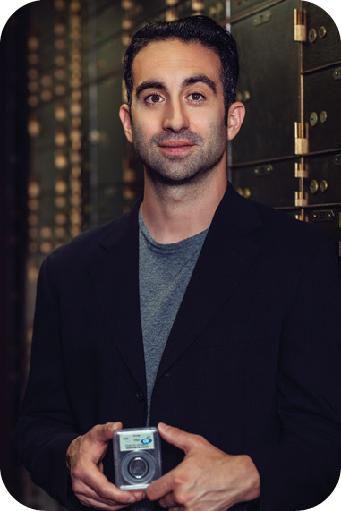

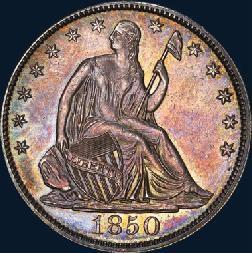




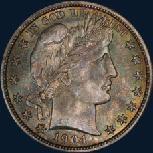
 By Jaime Hernandez
By Jaime Hernandez
The year 2023 is right around the corner. As we look back and reflect at some of the coins and banknotes that have sold this past year, it’s exciting to imagine what other great coins will come to market in 2023. There is always buzz in the coin market, and featured here are two amazing coins and a great banknote that recently dazzled on the auction block.

Considered by many to be the rarest business-strike coin issued by the U.S. Mint in the 20th century, the 1927-D Saint-Gaudens Double Eagle is a significant coin. It is estimated that only about a dozen or so examples exist. However, some of these are tied up in private institutions or museums. It is also believed that only seven examples are available to collectors, despite its large mintage of 180,000. A great rarity, this coin seldom appears on the market. When it is offered for sale, it commands strong interest and a hefty price. This is exactly what occurred on August 22, 2022, when a PCGS MS66 example was offered by Heritage Auctions and sold for an impressive $4,440,000.
a linebacker for the Houston Oilers from 1973 through 1985. He became a coin collector with a love for commemoratives. On June 19, 2022, his PCGS MS68 example was offered by GreatCollections, where it realized an astonishing $75,937.
1886 $10 Silver Certificate, PCGS Gem Unc 65 PPQ - Fr. 291.


1952-S Washington-Carver
The 1952-S WashingtonCarver Commemorative Half Dollar has a relatively low mintage, and finding examples graded above MS66 is extremely challenging. At PCGS, we have only graded 16 in MS67 to MS67+, showing how difficult this coin is to obtain in higher grades. There is just one graded PCGS MS68 with none finer, and this specimen is attractively toned with impeccable surfaces. What's also special about this coin is that it has a special pedigree, as the coin belonged to former NFL player Gregg Bingham, who was
The 1886 $10 Silver Certificate Fr. 291 saw only 400,000 examples printed, making it a very scarce banknote. The front top-left of the note has the “TEN” denoting its denomination, in dollars, spelled out; on the right it has the denomination with the “10” numerals. The front of the banknote also has the words “Ten Silver” and “Ten Dollars” in the middle area of the banknote. In between the two phrases, is a portrait of Thomas A. Hendricks, who in 1885, was the vice-president of the United States for a few months. On the lower right-hand corner there is a prominent red seal. The central back section of the banknote has two large “10” digits, and four smaller “10” digits at each corner of the banknote. On August 24, 2022, Stack’s Bowers Galleries offered an attractive example of this 1886 $10 Silver Certificate FR. 291, graded PCGS Gem Unc 65PPQ. This banknote, with a population of one at PCGS Banknote and no examples graded higher, sold for an impressive $78,000 at auction.
Jaime Hernandez is an editor for the PCGS Price Guide and has been a proud member of the PCGS team since 2005. By the time he reached his early 20s, Jaime was successfully buying and selling coins with some of the most prominent dealers and collectors in the country.
Email: jhernandez@collectors.com

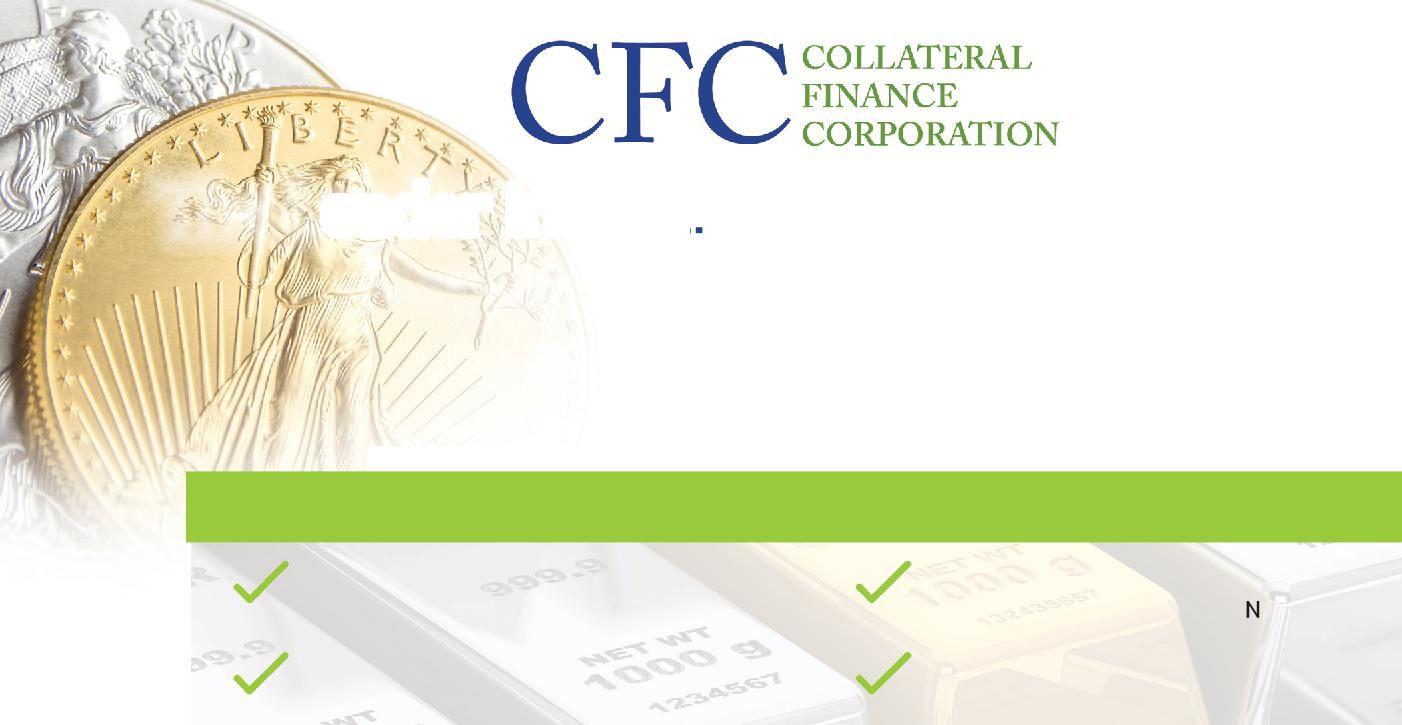

A continued theme for submissions to the PCGS office in Paris is the new discovery of rare United States gold coinage. This can be attributed to the tons of United States gold which moved its way to Europe. Recently a problem-free rarity – an 1882 $20 Liberty Head – was one such coin to surface in a Paris Express submission.
The 1882 $20 is the rarest date of James Longacre’s $20 Liberty designs, with a mintage of only 571 pieces. An additional 59 examples were struck in proof. The only $20 struck for circulation that is rarer is the 1861 Philadelphia Mint issue of the Paquet Reverse variety. No circulation 1883 or 1884 $20 coins were struck, making both of those proof only issues. While the mintage is only 571 for the 1882 business-strike $20, the survival rate is much lower with some estimating as low as 38 examples known. Currently, PCGS has a population report showing just 21 examples have been assigned a numeric grade and an alternative grading service has a mere 13 giving a population of 34. However, it is likely that there is multiple duplication in these numbers.

Condition is also an issue with the 1882 $20 coins. The finest-known graded by PCGS are two in MS61 in the population report. An example of the MS61 is currently in
the finest $20 Liberty set owned by D.L. Hansen. The last sales record for an 1882 Liberty Head Double Eagle was by Heritage Auctions on July 14, 2022. The specimen, hailing from The Allan H. Goldman Collection, was certified XF45 by PCGS and set a new auction record of $114,000, including the buyer’s premium.
In February 2022, a submission from the PCGS office in Paris contained an 1882 $20. This coin, after being authenticated by the PCGS team, was graded and certified AU53. This ranks the coin in the top 10 examples certified by PCGS with a PCGS Price Guide value of $125,000.

Jay began collecting coins at the age of 13, when he inherited his uncle’s coin collection. Turner is proficient in U.S. and world coins, token and medal variety attribution, grading, and counterfeit detection. In 2017, Turner joined PCGS as a grader specializing in world coins. He is stationed at the PCGS U.S. headquarters and grades on-site for the Shanghai, Hong Kong, and Paris offices.

The "Hookahi Dala" ($1) is the highest denomination of the set and also the largest physically, proudly displaying the eight major islands of the Hawaiian archipelago on its face.

Fractional denominations were printed to assist with a prevailing island coin shortage as well as stimulate additional local commerce and include the 3-Cent, the 1/2 Dollar and the 1/16 Dollar [seen here]. The 1/2 Dollar note features an image of the mellow mountainside location of the seminary itself. Courtesy of PCGS.
We typically showcase one single, exceptional note here that the PCGS Banknote team selectively handpicks out of the thousands of notes it certifies each month. In a departure from that one-and-done formula, this edition of Noteworthy Notes actually lives up to the pluralization of its column name by featuring an entire denomination set of notes – six in total. They simply cannot be broken up and profiled individually because choosing just one would be a travesty of justice (they are all equally cool!) and, furthermore, they just work much better together as a complete group.

Before we dig into this spectacular assembly of 1840s Hawaiian scrip from the storied Lahainaluna Seminary, a little discussion about Hawaiian history and geography may be helpful to set the stage. In 1898, the Hawaiian islands were formally annexed by the United States, initially as a territory before achieving full statehood in 1959. In the preceding decades of the 19th century, Hawaii was a unified, independently governed and globally recognized kingdom ruled by a series of monarchs who would grant land leases to
American businessmen and religious missionaries to build and operate plantations, factories, schools, and seminaries.
One such facility was the Lahainaluna Seminary. Located on the western edge of Maui island just northeast of Lahaina (Lahainaluna means “Upper Lahaina” in Hawaiian), the seminary was equipped with a press used to print religious and educational materials, legal documents, maps and other illustrations, the first newspaper west of the Rocky Mountains, and – yes – these fine circulating monetary instruments, printed via engraved copper plates on thin paper and then mounted on dark brown cardboard for durability’s sake. The miniscule print run of 228 sheets of scrip consisted of a little less than $450 in total face value, with each sheet containing one subject of each denomination from 3 cents up to 1 dollar.
Like many issues of private and municipal scrip over the years, a lack of available metal change (coinage) on the island necessitated the 1843-1844 printing of these paper stand-ins, which could then enter circulation to encourage and enable a more robust level of local commerce. When a certain amount
NOTEWORTHY
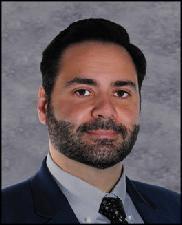
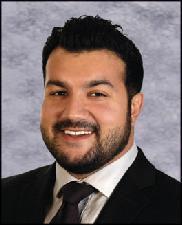

had accumulated, they could then be redeemed by the bearer at the seminary for silver or other goods.
This full denomination set consists of the 3-cent (or "Keneta" in Hawaiian), 1/16 dollar ("Hapaumi"), 1/8 dollar ("Hapawalu"), 1/4 dollar ("Hapaha"), 1/2 dollar ("Hapalua"), and the full 1 dollar ("Hookahi Dala") note. Designs representing Industry, Law, Science, Geography, Education, and the Hawaiian Islands adorn the faces of these notes, respectively.


There is an additional fascinating detail to this particular scrip issue that adds to their overall charm and wonder. According to the Hawaiian Money Standard Catalog (2nd Edition) by Donald Medcalf and Ronald Russell, the notes from this set – along with all other known single-note examples – were printed on altered plates with tiny secret marks meant to differentiate them from notes of the initial print runs that had been compromised by some level of unauthorized reproduction. It is believed that one of the seminary print shop's students was the culprit, using the original copper
19TH-CENTURY HAWAIIAN SEMINARY SCRIP
plates. At some point, only notes with these secret marks could be redeemed and anybody still holding notes from the older, tainted issue would be out of luck. Only one example of an unaltered plate printing exists – an uncut sheet of all six denominations. Talk about a real numismatic rarity!

Because banknote lots were hung on Southern California coin shop bid boards eye-level with a first-grader, a young Philip gravitated toward collecting notes versus their circular metal numismatic cousins in the mid-1980s. He has maintained his passion for banknotes ever since and joined PCGS in his current role as banknote specialist and research manager since the launch of PCGS Banknote in early 2020.

This 1866 Liberty Head Double Eagle With Motto is graded PCGS PR67DCAM and is the single-finest-known specimen of its kind. It was recently acquired by U.S. Coins and Jewelry of Houston, Texas. Courtesy of PCGS TrueView.

The year 1866 was pivotal for United States coinage, which was adopting the inscription “IN GOD WE TRUST.” The phrase first appeared on the Two-Cent Piece in 1864 but would not become the nation’s official motto until nine decades later in 1956. Amid the settling dust of the Civil War, which ended in 1865 after nearly tearing the nation in two, the inspirational sentiments of such a unifying message as “IN GOD WE TRUST” was welcomed by many during the uncertain days of Reconstruction. This rich history leaps off the surfaces of an extremely rare 1866 Liberty Head With Motto Double Eagle that was recently acquired by U.S. Coins and Jewelry of Houston, Texas.
Produced as circulation strikes and proofs, the 1866 $20 With Motto is scarce in any manifestation but especially so in proof. The Philadelphia Mint struck only 30 examples in proof, and PCGS estimates that about a dozen survive. Against the longest odds, the example presented here survived in resplendent PR67DCAM. This sensational gem stuns with its impeccable surfaces, the watery depths of its black fields contrasting against thick golden frost on the devices.

The Liberty Head Double Eagle is a quintessentially American coin, and this masterpiece of a specimen is without peer. Hailing from a long line of prestigious cabinets, this seven-figure rarity is now stewarded by one of the most renowned rare coin firms in the country. “It is an honor to add this beautiful rarity to our holdings,” said Blake Duncan, whose father, Kenny Duncan, a 2022 PCGS CoinFacts Coin Dealer Hall of Fame inductee, started U.S. Coins in the early 1980s as a wholesale firm that has grown exponentially. “Coins like this spark the imagination, vividly connecting the collector with the past.”
Nice proofs of the mid-1860s are simply tough to come by. Many were melted, spent as regular money, or have vanished in the mists of time. Those that remain are frequently encountered with evidence of
mishandling – dull surfaces, fingerprints, and other imperfections. Few are the proofs struck on the cusp of the Gilded Age that exhibit the flawlessness, crispness, and sheer perfection of this specimen, which was clearly regarded as something special and held with the utmost of care from its earliest days.
But history isn’t the only intrigue with this treasure. “There’s just one in this grade with none finer, making this piece the very best of the best a collector can obtain.” Added Duncan, “what’s better than that?”





Kenny Duncan is one of the biggest names in numismatics and was the founder of U S Coins His Houston-based numismatic firm was established in the early 1980s and is a market-making wholesaler that deals primarily in certified rare coins. Over the decades, Duncan has made a name for himself as a leading expert in choice-quality rare coins, not only attending many shows to acquire rare coins for his company’s expansive inventory, but also helping leading collectors assemble some of the most prestigious cabinets ever built. He has philanthropically contributed his knowledge and expertise to many and enjoys working with his sons Kenny, Blake, and Matt at the firm.
See the full list of inductees




There are 30 grades used by PCGS to grade coins, 1 being the lowest grade and 70 being the highest grade.
For a description of all the grades and designations used in the RCMR, refer to the PCGS Grading Standards listed in
this issue. Space does not permit us to show a comprehensive photographic grading guide here, but those interested in a detailed look at virtually all U.S. coins in all grades are referred to PCGS’s Photograde section, found at www.PCGS.com/photograde.
For regular strikes, the primary attribute for circulated grades, i.e. Poor (PO01) to About Uncirculated (AU58), is the amount of wear or the amount of the original design detail that is still evident. Other attributes contributing to the grade for circulated regular strikes are surface preservation and eye appeal, either of which can be positive, negative, or neutral and which affect the grade accordingly. For regular strikes in Uncirculated condition (MS60 to MS70), there are four primary attributes that determine grade: marks, strike, luster, and eye appeal.
A PCGS MS70 is a modern coin in "as struck by Mint" condition. Minor mintmade imperfections may be present. No damage or imperfections caused after minting. Not known in vintage coins.

A PCGS MS69 will show only one or two miniscule imperfections. Must be fully struck and have full original luster and eye appeal.
A PCGS MS68 will have some extremely minor imperfections. Must be sharply struck, have full original luster, and good eye appeal.
A PCGS MS67 will have some minor imperfections (marks, abrasions, etc). Must be well struck and have good luster and eye appeal.
A PCGS MS66 will have a few marks and/or abrasions. The strike, luster, and eye appeal must be good.
A PCGS MS65 will have some marks and/or abrasions, but they will be minor. The strike must be above average, and
Strike
The completeness/incompleteness of a coin’s intended detail when originally struck.
The strength and pattern of light reflected off a coin.
The condition of the surface of a coin, notably marks and/or scratches.
The element that “grabs” the viewer. The overall look of a coin. Often manifested as “toning.”
luster and eye appeal must be good.
A PCGS MS64 will have some marks and/or abrasions, and they may be significant. The strike and eye appeal should be average or above and must not be negative. Luster may be somewhat subdued.
A PCGS MS63 will have marks and abrasions that are moderate in number and/or size. Strike may not be full and eye appeal can be slightly negative. Luster may be somewhat dull.
A PCGS MS62 will have no wear on high points. There may be considerable marks and abrasions and some may be severe. Strike may not be full and eye appeal may be negative. Luster may be dull.
A PCGS MS61 will have no wear on the high points. There may be multiple heavy marks and abrasions. Strike may not be full, luster may be dull, and/or eye appeal may be negative.
APCGSMS60 will have no wear on the high points. There may be many heavy marks and abrasions. Strike may not be full, luster may be very dull, and/or eye appeal may be quite negative.
A PCGS AU58 will show full detail with minor friction on only the highest points.
A PCGS AU55 will show full detail with friction on less than 1/2 of the surface, mainly on the high points.
APCGSAU53 willshowfulldetailwith friction on 1/2 or more of the surface. There may be a very slight flatness on high points.
A PCGS AU50 will show full detail with friction over most of the surface and slight flatness on high points.
XF45 Detail is complete with most high points slightly flat.
XF40 Detail is complete with some high points flat.
VF35 Detail is 80 to 85% complete.
VF30 Detail is 70 to 80% complete.
VF25 Detail is 60 to 70% complete.
VF20 Detail is 50 to 60% complete.
F15 Detail is full in recessed areas. All lettering is sharp.
F12 Detail is evident in deeply recessed areas. Lettering is mostly sharp.
VG10 Design is worn with some detail evident.
VG08 Design is worn with only slight detail evident.
G06 Detailisflat,butrimsarecomplete. Peripheral lettering is full.
G04 Detail is flat. Rims slightly worn. Peripheral lettering nearly full.
AG03 Rims are worn but most lettering is readable though worn.
FR02 Mostly worn, but some design details are visible.
PO01 Barely identifiable as to date and type.
For proof strikings, the primary attributes of grade are hairlines and/ or marks (or lack of), reflectivity (for brilliant proofs), and eye appeal. Note that nearly all proofs are fully struck, thus strike is usually not a factor. Strike only comes into play when a
proof shows a partial strike, resulting in a downward adjustment of grade. Note that for toned brilliant proofs, the reflectivity is as perceived under toning.
APCGSPR70 shows no imperfections under five-power magnification. Brilliant proofs must be 100% fully reflective.
A PCGS PR69 will show only one or two miniscule imperfections. Brilliant proofs must be 100% fully reflective.
A PCGS PR68 will have some extremely minor imperfections. Eye appeal must be outstanding. Brilliant proofs will be fully reflective.
A PCGS PR67 will have some minor imperfections (hairlines or perhaps an extremely minor mark or two). Eye appeal must be very good. Brilliant proofs must be fully reflective or virtually so.
APCGSPR66 willhaveafewhairlines and/or very minor marks. Eye appeal must be very good. Brilliant proofs must be fully reflective or nearly so.
A PCGS PR65 will have minor hairlines and or minor marks. Eye appeal must be positive. Brilliant proofs must show good reflectivity.
A PCGS PR64 will have noticeable

hairlines and/or small marks. Eye appeal must not be negative. Brilliant proofs may have subdued reflectivity.
A PCGS PR63 will have obvious hairlines and/or marks. Eye appeal may be somewhat negative. Brilliant proofs may be dull.
A PCGS PR62 will have numerous hairlines and/or marks. Eye appeal may be quite negative. Brilliant proofs may be dull.
A PCGS PR61 will have lots of hairlines and/or marks. Eye appeal is negative. Brilliant proofs may not be reflective.
APCGSPR60 willhavenowearonthe high points, but will be very hairlined and/or marked. Eye appeal is negative.
Brilliant proofs may not be reflective. Proofs below PR60 for proof strikings grading below PR60, the grading is based on the amount of wear and the standards are the same as for regular strikes.
In addition to grade, certain coins have characteristics that collectors recognize as important and PCGS designates these characteristics using the standards that follow.




Full Steps (FS) PCGS designates Full Steps for Jefferson Nickels that grade MS60 or better and show a full five or six stepsintheportraitofMonticello(Thomas Jefferson’shome)onthereverse.Toqualify for this designation, a coin must also have nomajor disturbances, including cuts and marks, to the separation of the steps.
Full Bands (FB) PCGS designates Full Bands for Roosevelt Dimes that grade MS60 or better and show full separation of the upper and lower horizontal bands of the torch on the reverse. To qualify for this designation, a coin must also show no significant cuts or marks across the horizontal bands.
Full Bell Lines (FBL) PCGS designates Full Bell Lines for Franklin Half Dollars that grade MS60 or better and show full separation of the lines on the bottom of the Liberty Bell on the reverse. To qualify for this designation, a coin must also show no major disturbances, including cuts and marks, of the separation of the bell lines.
Prooflike Surfaces
Full Bands for Mercury Dimes that grade MS60 or better and show full separation of the central crossbands on the crossbands on the reverse. To qualify for this designation, a coin must also have no major disturbances, including cuts and marks, of the separation of the crossbands.

Full Head (FH) PCGS designates Full Head for Standing Liberty Quarters that grade AU50 or better and show full detail of Miss Liberty’s hair (on Type Ones) or helmet (on Type Twos); Type Ones (1916-1917) must show a distinct separation between the hair cords and the cap. Type Twos (1917-1930) must show three complete and distinct leaves to the helmet, a complete outline to the bottom of the helmet, and a distinct ear hole. Note that on the ultra-rare 1918/7-S, PCGS will designate Full Head on coins that grade XF40 or better and that meet the Full Head criteria.


Prooflike (PL) PCGS designates Prooflike for coins that grade MS60 or better and show clear reflectivity, i.e. mirrored surfaces at a distance of two to four inches. If the cartwheel effect or striations cause an area to lose clarity, the designation will not apply.

Deep Mirror Prooflike (DMPL) PCGS designates Deep Mirror Prooflike for Morgan Dollars that grade MS60 or better and show deep reflectivity, i.e. deeply mirrored surfaces. The differences between PL and DMPL is one of degree.



PCGS does not grade coins that are counterfeit, have been artificially toned, have had their surfaces altered, have been environmentally damaged, have been abrasively cleaned, have extremely large scratches, or have been repaired. Some allowances are made for ultra-rarities, Colonials, and Territorial gold coins, in which there are some instances when “net grading” is used by PCGS as a service to the numismatic community.
Cameo (CAM) PCGS designates Cameo for brilliant proofs that show light to moderate frosting of the devices. Both sides of a coin must have frosted devices to earn the Cameo designation.
PCGS Holder
No Grade coins are returned to the submitter with encapsulation. Code Reason 82 Filed Rims 91 Questionable Color 92 Cleaning 93 Planchet Flaw 94 Altered Surfaces 95 Scratches 97 Environmental Damage 98 Damage
Deep Cameo (DCAM) PCGS designates Deep Cameo for brilliant proofs that display deep, even frosting on the devices of both sides of the coin.
No PCGS Holder
No Grade coins are returned to the submitter without encapsulation. Code Reason 83 Peeling Lamination 86 Authenticity Unverifiable 90 Counterfeit 96 No Service 99 PVC Residue
Would you like further information about the PCGS Grading Standards, Designations, and No Grade Standards? View high-resolution images and in-depth videos for each at www.PCGS.com/grades. For PCGS Banknote grading standards visit www.PCGS.com/banknote/grades
Did Founding Fathers Paul Revere or John Adams hold any of these well-worn coins from the 1790s? Possibly… The portraits are public domain images sourced from Wikimedia Commons, and the coin images are courtesy of PCGS TrueView.



Many coin collectors spend years, even decades, building the perfect PCGS Registry Set. Most frequently, this would imply collectors who are chasing after coins in the highest grade achievable. However, there’s a small yet growing group of collectors who endeavor to complete sets of coins of the lowest-possible grade. For them, perfection isn’t enumerated by a “70” but rather by a “1,” and as is so often the case, landing a coin graded PO01 can be just as daunting a prospect as seeking a PCGS MS70. So, just who are these collectors and what drives them to aim… Low?
Low ball collecting has been an emerging area of numismatics over the past couple decades. By some accounts, a few collectors and dealers were already chasing low ball coins as a formal pursuit by the 1980s. However, longtime low

ball collector Christopher Lane said the origins of collecting extremely worn coins may date back more than a century. “I would guess that there were collectors back in the 1800s who put coins away that were worn out and that they thought were cool. One of the pioneers in the low ball genre, PCGS Hall of Famer Michael Hoyman, started with low ball Morgan Dollars well over a decade ago. I think the popularity has grown substantially in the past five years, with it really getting noticed in the past two years.”
For low ball collectors, an extensively worn coin is a manysplendored thing. “A pristine, uncirculated coin with a great shine or patina is beautiful,” remarked collector Dave LeBlanc. “But, to me, a very worn coin that got to that condition because it’s gone through hundreds or thousands of hands
Collector and fourth-generation dealer Andrew Edelman has a significant collection of low ball coins. Among these here is a unique Peace Dollar graded by PCGS with a handwritten label declaring it a “0.” According to Edelman, the specimen holdered three decades ago is “the only PCGS ‘Poor-0’ coin!” Courtesy of Andrew Edelman.

over its lifetime makes me want to wonder where it’s been and what it has been used for.” Said the owner of some “well-worn” coins from the 1790s, “Since I’m from the Boston area, I have to wonder if maybe any of these were ever used or carried by John Adams, Paul Revere, or their contemporaries.”
The historic potential of some low ball coins has fourthgeneration Philadelphia dealer Andrew Edelman, himself a collector of these well-worn coins, remarking, “I love knowing that these coins were used and held for decades, and the stories that they could tell.” He added, “I also like low ball collecting because it’s a field that’s immediately accessible to everyone, on any budget. No matter what field collectors are interested in, they can start a low ball set and enjoy another facet of numismatics!”
Broadly, the ideal low ball coin is one that has been worn to the point that the design is worn nearly flat but is still identifiable as to type, date, and mintmark. Many low ball coins fall into the range of Poor-1 (PO01) to About Good-3 (AG03), with some leniency in the range more inclusive of better grades for modern coins or series that did not circulate as extensively. A survey of low ball collectors provides more color.
“Looking at the PCGS Population Report, there are some coins out there which the lowest graded is Fine…” explains Lane, who adds that the threshold of “low ball” isn’t necessarily merely defined by an arbitrary grade level, such as G4. “Looking at a particular coin where the lowest graded is
Fine, then that is the lowest coin available if you are putting together a set of that coin’s series!”
LeBlanc says, “When talking about Classic Commemoratives only the Columbian and the Pilgrim [Half Dollars] have ever had more than 50 coins in total that have been graded by PCGS in the PO01-AG03 range. The lowest-graded Wisconsin and York [halves] are VF20 and VF25, respectively. So, for most commemoratives an AG03 or other low grade is an extremely tough find or one that hasn’t been found yet.” He further explains, “For Morgan Dollars or U.S. type coins, most [examples] in the certified PO01 and FR02 can be hard to find, some easier than others depending on mintage. Most coins with the ‘CC’ [Carson City] mintmark can be tougher and are at a premium.”
Adds Edelman, “There are certain issues that are just hard, oftentimes because of the wear patterns and how you still need a readable date to get them graded. I own one of only two PCGS PO01 Three Cent Nickels ever graded, which might surprise people that there’s only two.” Then there are contemporary series that have seen little or even no official circulation but nevertheless yield extremely worn specimens. How does that even happen?
“Most of the modern low ball coins are pocket pieces,

although I have personally gotten a Sacagawea Dollar from a SEPTA (Southeastern Pennsylvania Transportation Authority) subway vending machine that is probably a low Fine!” says Edelman. He explains that American Silver Eagles with organic wear must have been pocket pieces as they are truly non-circulating. “But I could absolutely see an Ike or golden [Sacagawea] dollar naturally getting extremely worn, they are just extremely hard to come by. There are other ways coins can gain wear, such as being stuck under a frequently used chair or seat, but most of the PO1 examples of modern coins were pocket pieces for many years.”
The dealer warns that low ball collectors need to be careful discerning between truly worn coins and those that were altered to look like they saw heavy circulation. “As low ball collecting becomes more popular and low population PO01 coins start to bring thousands of dollars, the prevalence of ‘artificially worn’ coins has started to increase.” Collectors are reminded they should stick to buying low ball coins certified by PCGS, whose experts can distinguish between a coin that has received genuine wear versus artificially accelerated wear.
And it’s the type of wear itself that can drive a low ball collector’s ambitions. There is the question of whether to collect so-called “straight-grade” coins (the kind that are
certified with only a grade on the label and no notes, such as “scratched,” “holed,” etc.) or those that carry damage. “Initially, I had no-date and holed coins in my low ball set, but I now enjoy my PCGS Registry sets, which dictate that the coins must be straight graded,” says Edelman. “You can absolutely enjoy low ball coins if they are holed or damaged, but I choose to stick with only straight graded coins at this time.”
LeBlanc, who also prefers “problem-free” low ball coins, says, “There are a number of collectors that just look for holed, culled, or error coins, and that’s great. It’s just wherever someone’s interest lies.”
The PCGS Set Registry recognizes a slew of low ball categories, with more on the way to meet demand. However, the most popular areas are clustered around the major U.S. series from the late 19th and early 20th centuries, with specialty interest for modern low ball efforts, including sets of Kennedy Half Dollars and Eisenhower Dollars.
“I saw an Iowa [State Quarter] graded VG08 in an online auction and I was able to get it at a reasonable price,” recalls LeBlanc of his early low ball collecting ventures. “That started

me working at putting together a low ball commemorative set. While slowly trying to find some of the last coins to finish that set, I started collecting low ball Morgan Dollars and U.S. type set coins.
Lane is also pursuing a low ball type set, a 97-piece copper, nickel, and silver assemblage that he has “worked on for decades” and considers a monumental endeavor.
Edelman enjoys type sets, too. “I have the second-highestrated PCGS Registry low ball set for a complete 133-coin U.S. type set.” He also has a nearly complete low ball Peace Dollar set. “My original classic commemorative set will always be a work in progress, although that set is extremely competitive with a number of very serious collectors participating.”
A collector who goes by his Set Registry handle “Lopezjohn” says he started collecting coins and stamps years ago as a teenager. Now he is a PCGS Set Registry member who pursues among many things low ball Barber Dimes, which offer a mixed bag of challenges for collectors like him. “Barber Dimes are harder to find in lower grades since they were used and used,” he noted of the coins, which were often worn beyond the point of attributing their date and mintmark. “The later years are harder since people kept them for silver and collections.”
The marketplace dynamics for low ball coinage isn’t really unique – it comes down to the function of supply versus demand. What’s different and perhaps even perplexing for those not attuned to this aspect of collecting is how a coin graded Poor or Fair could realize a significantly higher value than one encapsulated Fine, Very Fine, or even better. “When you get right down to it, some of these really tough PO01 coins are much rarer than their high-grade counterparts,” asserts Lane. “The high-grade coins were pulled from the mint, banks, etc. and carefully put away. Imagine a coin like a Three Cent Silver – small, thin, easily damaged, and oftentimes used as a screwdriver in the day! After all these years, how many survived undamaged, unmelted, and ended up in perfectly worn low grades?”
Observes LeBlanc, “A few years ago, I did a presentation at a coin club and I showed an MS65 Huguenot Commemorative Half Dollar valued between $200 to $250. While this was a very nice and collectible coin it wasn’t really rare since there had been over 1,700 graded at that level or higher. I then explained that there were four graded MS68 and only one at MS68+. I asked if anyone would like to have one of these rare coins if money was no object since the current price

guides listed their values between $25,000 to $32,000. The ‘yes’ votes were unanimous. I then showed them a Huguenot graded FR02. Back then there were only four of these and only one PO01. The cost of these would be much closer to the cost of the MS65 even though they were just as rare as the MS68.” He noted that he received three offers on his FR02 Huguenot Half Dollar at that meeting following his presentation.
Edelman says that as a dealer his experience in transacting low ball coins has been quite successful. “I’ve found the low ball coins I do decide to part with have sold very well. I think there’s a much larger collector base than some might expect, which makes me optimistic for the growth of this niche market.” He says interest in low ball coins is absolutely growing. “I expect there to be more collectors who realize it’s a very fun, cost-effective way to collect the coins they love!”


Market fundamentals, regardless of the particular market itself, are pretty straightforward. Is there demand for a product or a service? Is someone (or a company) able to provide that product or service at an acceptable price to the market while still making a profit?
Product and service types tweak this demand/supply curve. Rare coins fall into a limited-availability end of the spectrum versus a good or service that can be easily manufactured, produced, or provided. Like many natural resources that are or will be in short supply, rare coins aren’t being made anymore. Yes, there is the exception of modern mint products, but we’re talking about (mainly vintage) rare coins here.
Rarecoinsarelimitedinsupply.Somecoinswhileadvertised as rare are not – they are merely scarce or unusual. Yet, even these scarce and unusual coins often bring exceptional prices depending, once again, on the demand and if there are any available at that particular moment in the market.
Who cares if the price guide for an item is $1,000 and you know it’s undervalued? If you can’t buy one, what’s the point? On the flip side, who cares if you can get $1,000 each for a supposed common item if none are available at that price? It’s a moot point – no business in either direction.
At some point, the demand pushes the price to a level acceptable to a seller. Most of the time, it’s a combination of the seller wanting to realize a profit and the buyer willing to pay a premium over the supposed market rate. Rare coins don’t fit perfectly in this model either.
It all comes down to the supply. Especially with conditioncensus coins, the top 10 coins, of a particular date and type, don’t appear on the market often. Unprecedented demand often accelerates the number of condition-census coins to be offered. We’re seeing great coins come into the market because the conditions are great!
So what’s different about the market now? The singlelargest factor driving the rare coin market today is the sheer
amount of money available to buy coins. The rare coin market in decades past had some millionaire collectors and investors. Now we have billionaire rare coin collectors – in other words, just add three zeros!
The surge in price for other high-end collectables too is no surprise either. Collectors and investors both are vying for historically significant items because they represent tangible value. Maybe collectors buy rare coins because they love them. Maybe investors buy coins because coins are undervalued. Regardless, they are both buying.

Because the supply is limited, there are particularly elusive coins that are sought in all markets. The savvy collectors and investors know that if a particularly rare coin, almost always condition census, appears on the market the coin will bring a strong price, often despite the overall rare coin market itself. With rare coins, it often comes down to when… When will you be able to buy another?
The success or failure of a market, too, is dependent on timing. As long as the economy remains in an inflationary mode as it is now, the rare coin market will continue to be a safe harbor for most collectors and investors.
Vic Bozarth is a familiar face on the bourse floor to many who have attended coin shows over the last five decades. He’s a self-described “coin wheenie” who has attended more than 1,000 shows and vast experience both buying and selling many of the finest PCGS coins. His numismatic knowledge as a dealer and collector provides a unique perspective on our industry.

The 1970-S Jefferson Nickel in PCGS MS66FS, as seen here, is a hot item with blazing performance on the Market Movers & Shakers list. Courtesy of PCGS TrueView.
As we approach the end 2022, the modern coin market has remained strong. In this article, we will highlight some of the modern pieces that have performed the best over the past year.

The first coin on our Market Movers & Shakers list is a 1970-S Jefferson Nickel graded PCGS MS66FS. One might think that this coin would be very common in the MS66 grade or in better condition, since the U.S. Mint struck over 214 million examples. However, this issue is more commonly found with weak strikes or a myriad of other surface issues – nicks, scratches, etc. So, it can be a big challenge to find an example above MS65, let alone with the Full Steps characteristics. PCGS has graded only 11 total examples in MS66FS (Full Steps), with none being graded higher for this issue.

At the same time, the highest-graded examples at PCGS for 1970-S without the Full Steps is MS67. So, the price of the 1970-S in PCGS MS66 jumping from $125 to $650, or a 420% increase seems justified in this instance.
The second coin on our list is a very interesting entry. It is a $1 2014 Calvin Coolidge Presidential Dollar, Missing
Edge Lettering. This coin happens to be the only graded example at PCGS in any grade, and it is graded PCGS MS65. In May 2014, it was discovered in a roll of 2014-D Coolidge Presidential Dollars and was submitted to PCGS. At the time, this was the only example of this issue known with the missing edge – an error found on other Presidential Dollars but not the Coolidge emission until that time.

As of this writing, this is still the only PCGS example, and I am not aware of any others surfacing since. Being a unique coin containing a major variety or error and belonging to a very popular series, it was a no brainer that the coin justified a significant price increase. It jumped in price from $2,500 to $8,500 in the past year for an increase of 240%!
While space limitations preclude us from going into detail on all the coins in the Market Movers & Shakers list here, it is interesting to note that all 10 coins referenced on the list increased in value by over 100%, with some even increasing more than 200% in the past year. Keep in mind, these are just 10 modern coins that have performed well this year. The complete list has many more modern coins that have seen
remarkable performance over the past 12 months. To view the entire list, please visit the PCGS Price Guide at PCGS.com and click under “Price Changes.”
Jaime Hernandez is an editor for the PCGS Price Guide and has been a proud member of the PCGS team since 2005. By the time he reached his early 20s, Jaime was successfully buying and selling coins with some of the most prominent dealers and collectors in the country. Email: jhernandez@collectors.com “I

— Chris Victor McCawley
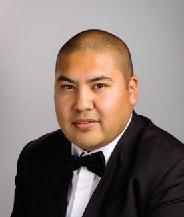
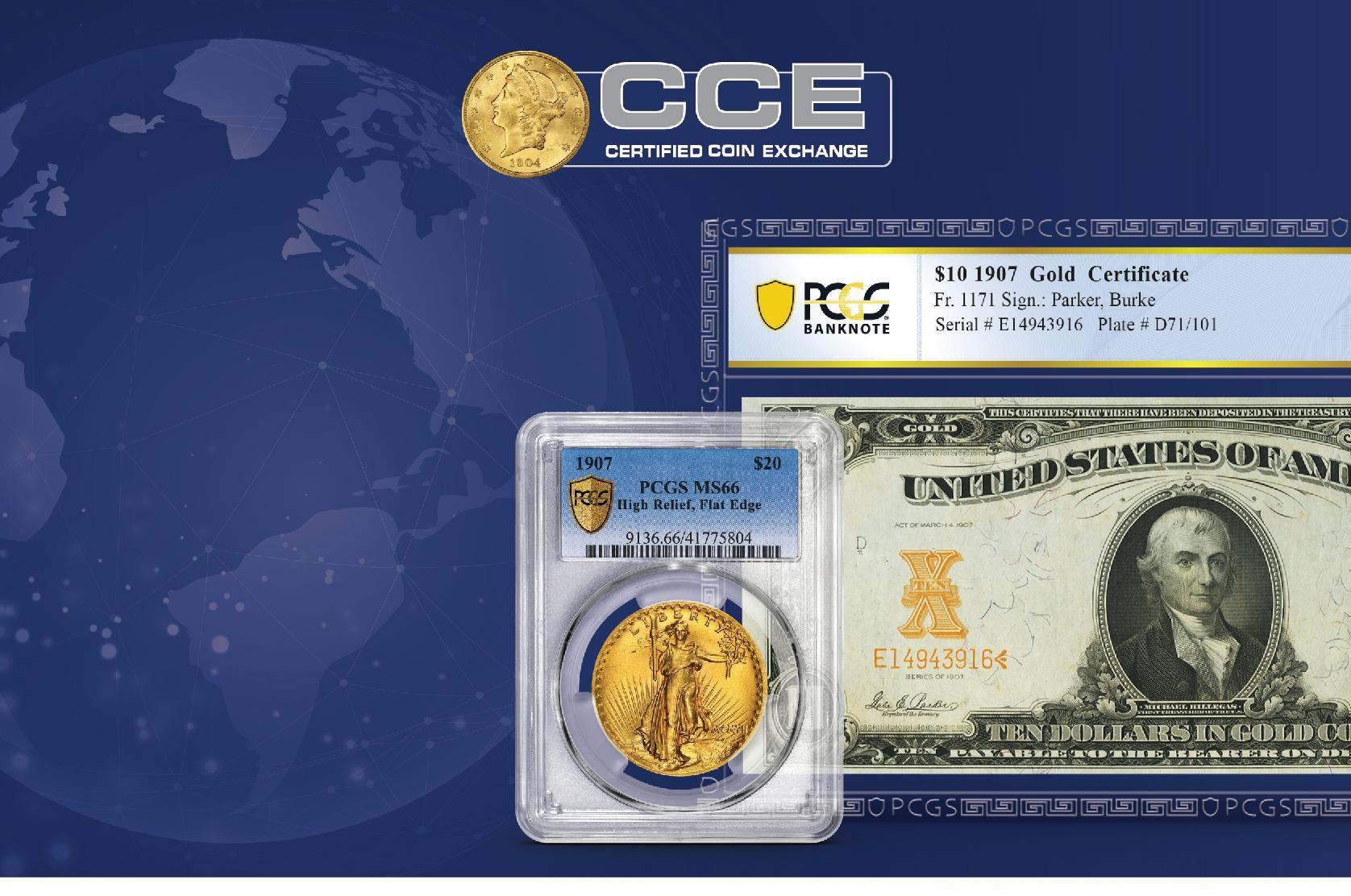

 By Vic Bozarth & Mark Ferguson
By Vic Bozarth & Mark Ferguson
coinage, which is an indication of a healthy collector base for those coins.
Prices for r some coins, like Carson City Morgan Dollars, may be ike softening while the market continues getting only hotter still for other entries. Courtesy of PCGS TrueView.
Affluent Set Registry collectors continue to compete with each other at auction to acquire the highest-grade top-pop coins, pushing prices to new higher levels. There’s been no let up in demand for the finest coins throughout the various U.S. series since this trend began about two years ago. Several billionaire collector/investors have taken an active interest in building the finest collections, and this capital infusion ripples through the coin market.
Higher prices at the top end of the market have allowed competing buyers to push prices higher for high-grade coins that fall short of being top pops. Adding to this price pressure from collectors is demand from dealers who need to make inventory purchases to replenish depleted inventories and to invest their increasing profits. While auction activity is easy to follow and track because it’s public, such private trades across the coin market aren’t. In our experience, private sales greatly eclipse the sales volume of public auctions.
Price resistance has begun to emerge for some costly coins in circulated grades, as well as for Mint State coins that are less than gem quality. For example, dealers have reported to us that Mint State Carson City Morgan dollars from the GSA Hoard are plentiful in the market, causing slight price softening. On the other hand, collectors are stretching at auction to buy scarce PCGS-graded circulated Liberty Seated
In other areas, softening precious metals prices have put downward pressure on mid-grade common coins like SaintGaudens Double Eagles that are closely tied to gold bullion pricing. Silver Eagle collectors have had to endure rising premiums over bullion prices that have climbed to around $12 per coin. But while premiums have remained high, lower silver bullion price levels have given collectors a break from a silver price that was higher than $26/ounce earlier in the year to significantly less than $20/ounce as the year has progressed.
We have seen no indication that the coin market, in general, is poised for a major correction. Quite the contrary scenario is what we see. The coin market is still attractive to collectors and investors who want to park money. And this is especially true as the outlook for stocks remains weak. One barometer that showed strength in the coin market was activity at the American Numismatic Association World’s Fair of Money held in the Chicago area in August. Anecdotally, the bourse floor was teeming with people throughout the show until the last couple days. Not only that, the bourse floor remained well-attended toward the end of each day when it usually thins out late in the afternoon.

A walk around the bourse floor at the World’s Fair of Money revealed a lack of interesting high-end coins displayed, compared to what was seen just two or three years earlier. About 20 years ago, as the coin market began recovering from the slow market endured during the 1990s, large auction companies became more successful in enticing better coins away from dealers, in that collectors who were selling found it more attractive to consign their coins to auctions rather than sell them to dealers. Previously, as prices continued to soften during the 1990s, auctions fell out of favor as the preferred way to sell coins, except for large famous collections.
Consignment to auction plus increasing demand from collector/investors who have been holding coins off the market for long periods of time has created a situation in which
High-grade rarities like the 1916 Standing Liberty Quarter and 1921 Walking Liberty Half Dollar are being closely held by collectors who seemingly refuse to let them go, even with the tempting offer of robust prices. Courtesy of PCGS TrueView.

dealers have been struggling to find interesting coins to buy for inventory. Many dealers have compromised on what they’ll buy. For example, a dealer who mainly stocks Mint State coins might buy a collection or group of circulated silver dollars just to have something to buy and sell and turn for a profit.
In reviewing auction prices realized, as the PCGS Price Guide team does every day, it’s not unusual to see numerous examples of important coins that have not come to auction in many years. For instance, PCGS has graded four examples of the 1921 Walking Liberty Half Dollar in MS66. The last one to have sold at a major auction was in 2015 and before that we have to go all the way back to 2002. PCGS has graded six nonfull head 1916 Standing Liberty Quarters in MS66, with none of them coming to auction since 2013. Two examples grade higher – MS66+ and MS67. If you want a top-pop 1880-S Morgan Dollar, perhaps the most common-issue Morgan that can be obtained in Gem condition, of which PCGS has graded five in MS69, just one has ever been sold at auction –in January 2021.
Fortunately, as some collectors upgrade coins, they sell off the duplicates they’ve upgraded, or once they’ve completed sets they decide to sell and begin again with another series. Three well-known collectors who have been well-publicized come to mind who deaccession coins while continuing to build their collections are Dell Loy Hansen, Bob Simpson, and Dr. Steven Duckor. They’ve purchased complete sets just to obtain a few coins, upgraded individual coins, and sold off sets to begin again with another series.
In another twist, Ian Russell of GreatCollections has been able to acquire several famous trophy rarities for clients by seeking them out and offering their owners higher-thanmarket prices in order to pry the coins away from their owners. That was much easier to accomplish during the 1980s when money talked, so to speak, but these days, collectors have largely been holding on to their rarities for the long-term.
We encourage collectors to use similar creative methods to locate and obtain important coins. Dealers who are well connected and/or have large client bases are logical choices to get help in acquiring important coins.
Vic Bozarth is a familiar face on the bourse floor to many who have attended coin shows over the last five decades. He’s a self-described “coin weenie” who has attended more than 1,000 shows and vast experience both buying and selling many of the finest PCGS coins. His numismatic knowledge as a dealer and collector provides a unique perspective on our industry.
Mark Ferguson began buying and selling coins in 1969. He graded coins for PCGS between 1986 and 1990 and currently serves as the company's senior price guide consultant. He’s a numismatic researcher, writer, appraiser, and advisor, and he authored The Dollar of 1804: The U.S. Mint’s Hidden Secret.




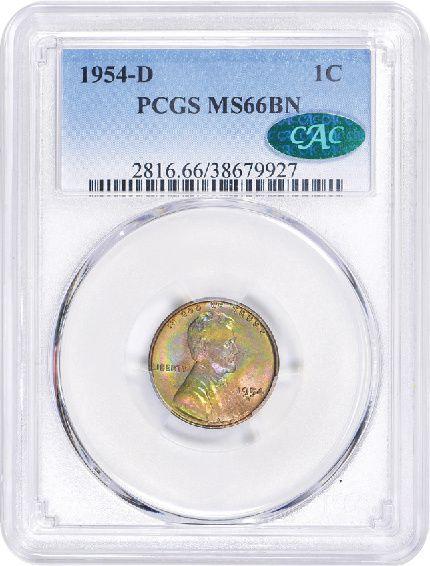


Certified Coins:GreatCollections welcomes coins graded by PCGS, NGC (NCS) and ANACS. Please remove all labels/stickers adhered to holders.

RawCoins: If your coins are not graded, please use our Raw Coin Consignment Form. GreatCollections extends our discounted rates for coin grading directly to members.
Insurance: From the moment your coins arrive at GreatCollections, they are covered by our extensive insurance policy with Lloyd’s of London... another benefit provided to all consignors at no cost.
Values: If you are unsure of coin values, please leave this field blank. We review all coins that are consigned and will assign values and minimum bids accordingly.
Listing Fees: Our listing fees are based on the following schedule and are charged the first time the coin is listed at GreatCollections.
Minimum Bid Listing Fee

$1-$99 $3 $100-$999 $5 $1,000 and up $10
Up to Five Listings for One Fee: For one listing fee, GreatCollections will relist any coin that doesn’t sell, up to a maximum of five times without any additional listing fees. If you do not want your coins relisted, please let us know under “Special Instructions” on the reverse of this form.
Cash Advances: We offer generous cash advances for all consignments at a competitive interest rate. Checks can be sent via overnight Fedex or Express Mail within 24 hours of your coins arriving at GreatCollections. Please check the box on the reverse of this form (below the signature line) and we will contact you as soon as we have reviewed your coins.
TimingandScheduling: Coins are generally listed on our website within 7-21 days of arriving at GreatCollections. If you consign duplicates of the same year, denomination, grade and grading service, we will typically split the coins over multiple days of auctions. Once coins are entered in our system, you can view
1. Consignor agrees that the Auction shall be conducted online by GreatCollections according to the Terms and Conditions published at www.greatcollections.com/terms. This agreement is subject to Arbitration.
2. Consignor warrants that: (1) Consignor is the legal owner of and has full title and interest in the coins/items consigned to GreatCollections; (2) all coins/items consigned to GreatCollections are free and clear of any liens, encumbrances, security interests or contract rights restricting the unconditional right to sell all rights, title and interest in and to such coin/item; and (3) all consigned coins/items are authentic and in respect to certified coins, holders have not been tampered with or resealed.
3. Consignor agrees to pay GreatCollections a Listing Fee for each coins/items offered by Auction and for coins/items sold, a Seller’s Fee. All fees are detailed on the reverse of the Consignment Agreement.
4. In the event that your coins do not sell in their first Auction, GreatCollections agrees to relist coins/items up to four additional times. There will be no Listing Fees charged for these four additional relistings. Should you prefer your coins not to be relisted, please note this in the “Special Instructions” box on the Consignment Form.
5. Consignor acknowledges that the Hammer Price is the final bid price accepted by the Auctioneer. The Hammer Price does not include the Buyer’s Fee, which GreatCollections retains in full.
6. GreatCollections has the right in its sole discretion to reject any Consignment, to cancel any Auction, to postpone or change the date/time of Auction and/or to rescind any sale. GreatCollections also reserves the right in its sole discretion to cancel or reject any bidder from bidding, when we believe it is not in the Consignor’s and/or GreatCollections’ best interest.
7. A Consignor is able to list a Minimum Bid on every coin/item consigned, according to the three options listed on the Consignment Form. It is up to the Consignor to verify that the correct Minimum Bids are entered as soon as their coins/items are uploaded to the GreatCollections website. Any corrections should be reported as early as possible before the end of the Auction. This Minimum Bid amount is disclosed on all items/coins listed at GreatCollections. Consignor may not withdraw any coin/item for any reason.
8. If the successful bidder or buyer is in default and GreatCollections is not satisfied that the amount due for any particular Consignor’s lot[s] will be paid in full, GreatCollections reserves the right to take one or more of the following actions: (1) declare the sale null and void and return the coins/items to the Consignor; (2) declare the sale null
your coins by logging into MyGC and clicking on “Items Pending” or “Currently Selling”.
Currency/Paper Money:GreatCollections also auctions certified currency and paper money graded by PCGS and PMG, together with our exclusive Grade & Auction program offering discounted grading rates. Please use our currency consignment forms.
CAC: CAC is a third-party grade verifier founded by John Albanese that reviews PCGS and NGC-graded coins (excluding moderns). GreatCollections is an authorized submitter and can arrange CAC to review your coins prior to auctioning. The process takes about 10 days. Cost is $15 for coins valued up to $10,000, $30 for coins valued up to $25,000 and $50 for coins valued at over $25,000.
Minimum Bids: We offer three convenient ways to set Minimum Bids at GreatCollections.
1. You may select GreatCollections to establish a Minimum Bid based on our knowledge of the coin market. We usually set opening bids at 70% of what we believe the coins are worth in today’s market. This is our recommended option that we have found to generate the most bidding activity while protecting you with a Minimum Bid.
2. You may select a percentage of the Values you have listed on the reverse of this form to use as Minimum Bids. Please check either the 50%, 65% or 80% option.
3. You may select that all coins start at a Minimum Bid of $1. This is recommended for liquid/popular coins and is used regularly by dealers, investors and representatives of estates.
Regretfully, we cannot accept consignments where the Minimum Bids are higher than 80% of their listed value. If you have any questions regarding setting Minimum Bids, please call us at 1.800.44.COINS (+1.949.679.4180) or e-mail info@GreatCollections.com.
Seller’s Fees: Our Seller’s fees are a low 5% for coins up to $1000, and 0% for coins over $1,000.
Consignment Proceeds: Checks are mailed within 30 days of your coin(s) selling. To confirm the payment date, please login to your account at GreatCollections, click on MyGC and “View Consignor Statements”.
and void and reoffer the coins/items in another Auction; and/or (3) proceed against buyer on behalf of Consignor. In addition, GreatCollections offers a return privilege to Buyers. Should your coin/item be returned, we will cancel the sale and relist your item. In the event that GreatCollections cancels the sale of your coins/items or your coins/ items are returned, all Listing Fees and Seller’s Fees will be refunded to Consignor.
9. If you consign raw coins/items to GreatCollections, we will send your coins/items to a major third party grading service such as PCGS, NGC and/or ANACS. For more information, please refer to the Raw Coin Consignment Form, which can be downloaded at www.greatcollections.com/forms.
10. GreatCollections shall remit to Consignor, within 30 days after the close of the Auction, the net proceeds, which equals the Hammer Price less Seller’s Fees, Listing Fees, Interest for Cash Advances, other monies owed to GreatCollections by Consignor and Cash Advances Principal (in order). In the event the Consignor’s sales do not exceed fees or monies owed to GreatCollections, the Consignor agrees to pay GreatCollections all monies owed within seven days of invoice date. In certain instances, an introductory commission may be paid by GreatCollections to an agent of Consignor for referring the Consignment to GreatCollections.
11. GreatCollections will provide insurance for loss or damage for consigned coins while in the possession of GreatCollections and while any are being shipped back to the Consignor, subject to certain terms and exclusions (such as Earthquake coverage). In the event of an insurance claim, our insurance carrier will pay you the Fair Market Value, less the Seller’s Fees and Buyer’s Fees, based on the total insurance proceeds. This payment to you by the insurance carrier shall completely satisfy our obligations regarding the Consignments under this Agreement.
12. Arbitration. Any claim or dispute arising out of the sale of coins/items by GreatCollections shall be settled by arbitration between the parties in accordance with the rules of the Professional Numismatists Guild (PNG) or if the PNG cannot or will not hear the matter, by the American Arbitration Association (AAA). Any claim must be commenced within three months of the Auction date or Buy Now confirmation or the claim is waived.
13. This contract is the entire Agreement between the parties and supersedes all prior Agreements. The warranties and representations contained in this Agreement survive the date of execution by each party herein and the performance of all terms and conditions contained in this agreement. This Agreement shall be governed by the laws of the State of California.
Contact Us:
GreatCollections Coin Auctions 17500 Red Hill Ave. Suite 160 | Irvine, CA 92614
Endo Customer Service Director/OwnerPhone: 1.800.44.COINS | 1.949.679.4180 Email: info@greatcollections.com | www.GreatCollections.com
 Ian Russell President/ Owner
Raeleen
Ian Russell President/ Owner
Raeleen

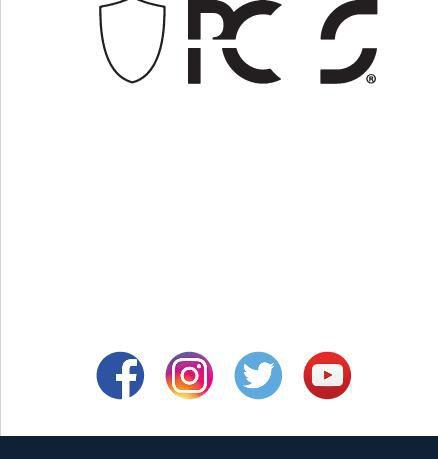

An 1855-D Gold Dollar with a full date is a rarity, with most examples of this issue exhibiting a weak date. Courtesy of PCGS TrueView

A more typical example of an 1855-D gold dollar bearing the weak date and showing clash marks as well as other distractions. Courtesy of PCGS TrueView.
I recently had the pleasure of handling one of just four known uncirculated 1855-D gold dollars that had been part of the Auraria Collection of Dahlonega gold coinage. Graded MS61 by PCGS, this coin exhibits an especially sharp strike for the date with all four digits 100% detailed.
Interestingly,thisisthesole1855-Dthathasbeendesignated as “Full Date” by PCGS. The other three Uncirculated 1855D gold dollars have been graded PCGS MS64+, PCGS MS64, and PCGS MS62. The first is a Full Date, while the second and the third are a Weak Date.
This is the third time I’ve sold this coin since 2003 as I’ve placed it, previously, in the Vasquez Rocks Collection of gold dollars and earlier in the Green Pond Collection. For all three individuals I’ve sold this coin to, a key factor in the successful transaction was the clarity of the date.
I’ve written about the Full Date 1855-D Dollar before, but I thought it would be appropriate to revisit this issue.

How rare is this variation? I believe that of the PCGSestimated 80 known 1855-D gold dollars, there are an estimated dozen-plus known. Just for kicks, I went through auction records of all the straight-graded 1855-D Dollars sold
since 2010. Of the 31 records of sale, 10 were Full Date coins while 21 were Weak Date coins. But this is misleading, as at least two of the Full Date coins have been offered multiple times since 2010. As far as I can tell, there were around six distinct Full Date coins.
Then I went through the Doug Winter Numismatics database, which also covers the last 10-plus years. During this time, I’ve sold nine coins, with four being Full Dates and five Weak Dates. However, this ratio doesn’t factor in my personal bias toward Full Date coins versus the less-desirable Weak Date pieces.
There are two die varieties for the 1855-D, and they are as follows:
• Variety 7-I: Quickly identifiable by the position of the second “5,” which is fully below the “A” in “DOLLAR.” Always seen with extensive clash marks from the reverse on the obverse.
• Variety 7-J: Quickly identifiable by the position of the second “5” which is slightly right of the “A” in “DOLLAR.”
The first variety is at least three times as scarce.
More importantly, only Variety 7-I shows the early die-state Full Date coins.
There are at least three die states for Variety 7-J:
• On the first, there is some weakness mainly on the “8.”
• On the second, the weakness is more extensive with considerable weakness seen on the “8” which extends up to the “LL” in “DOLLAR.”
• On the third, the “8” in the date is barely visible (or not all) while the “OLL” are now very weak.
In the past, I have written that there are fewer than 10 known examples of the 1855-D Full Date Dollar. I now think this figure is slightly low, with perhaps 12 or a few more known. This includes the two uncirculated pieces I mentioned above as well as four or five in AU and another four to six in XF.
Now that PCGS designates Full Date coins, I believe that these will become far more desirable than their Weak Date counterparts and that they will command a significant premium. But how much of a premium? My guess is that a
more affordable collector-grade 1855-D Full Date (say in XF45) will eventually sell for as much as a 50% premium. The more expensive higher-grade pieces will see a smaller premium due to the high entry cost on entry.
With the Dahlonega-mint coin market now showing a lot more tolerance for strong variety premiums, my gut says that premiums for the 1855-D gold dollar will increase if they continue to be service designated and collectors see for themselves the improved aesthetics of a Full Date versus a Weak Date.
Doug is an award-winning author of over a dozen numismatic books and the recognized expert on US gold. He can be reached at 214675-9897, at dwn@ont.com or through his website, www.raregoldcoins.com.



